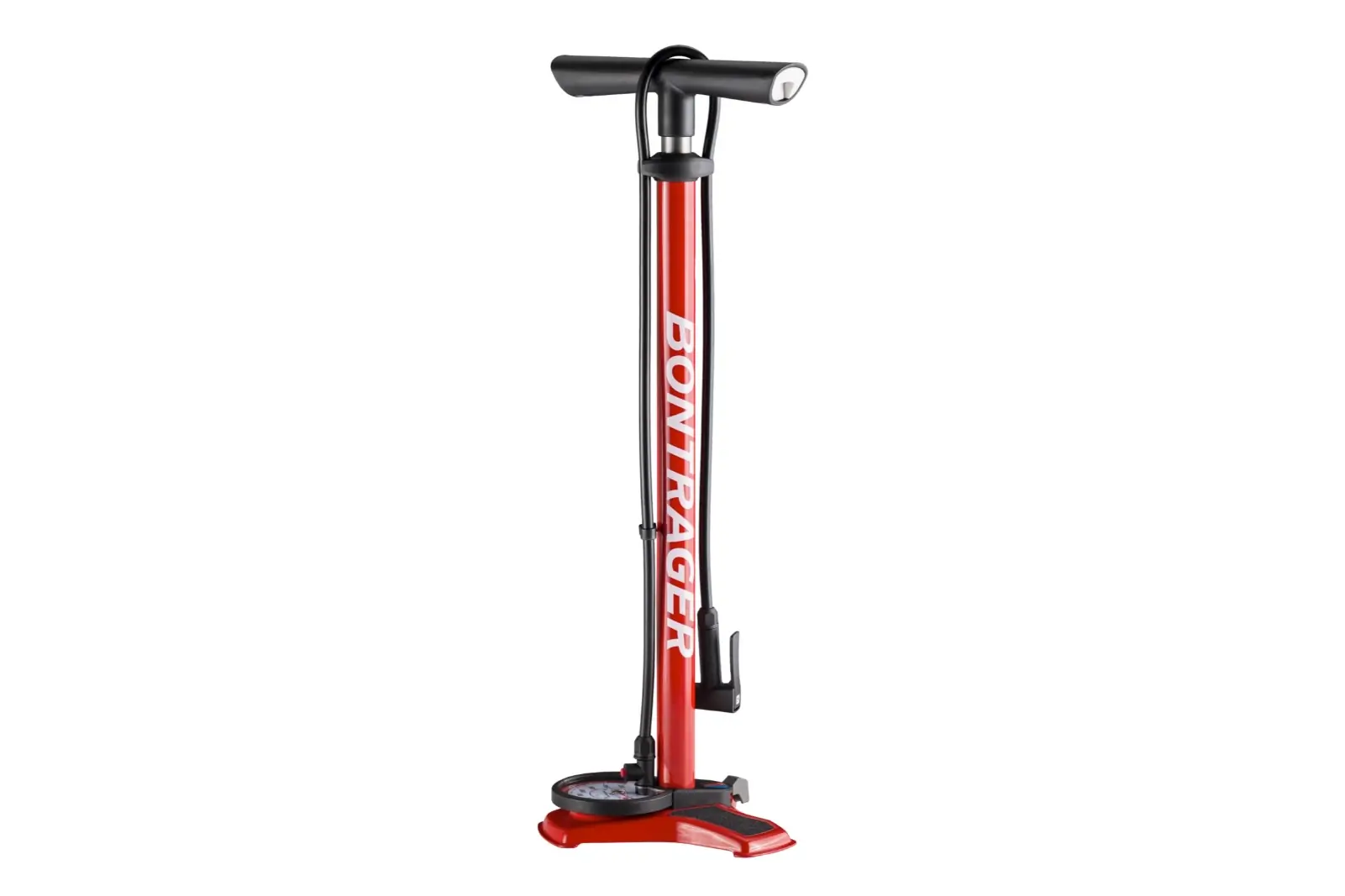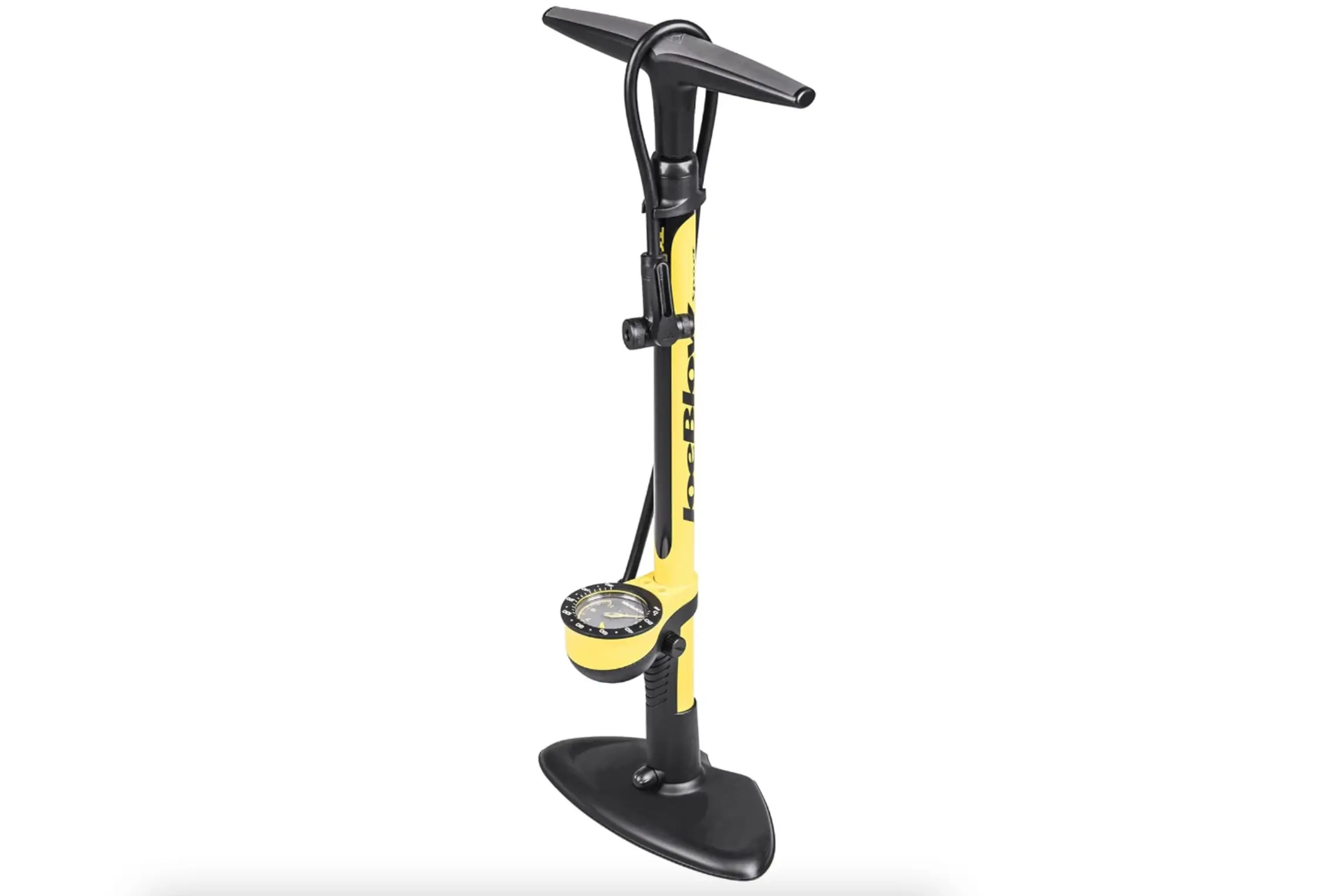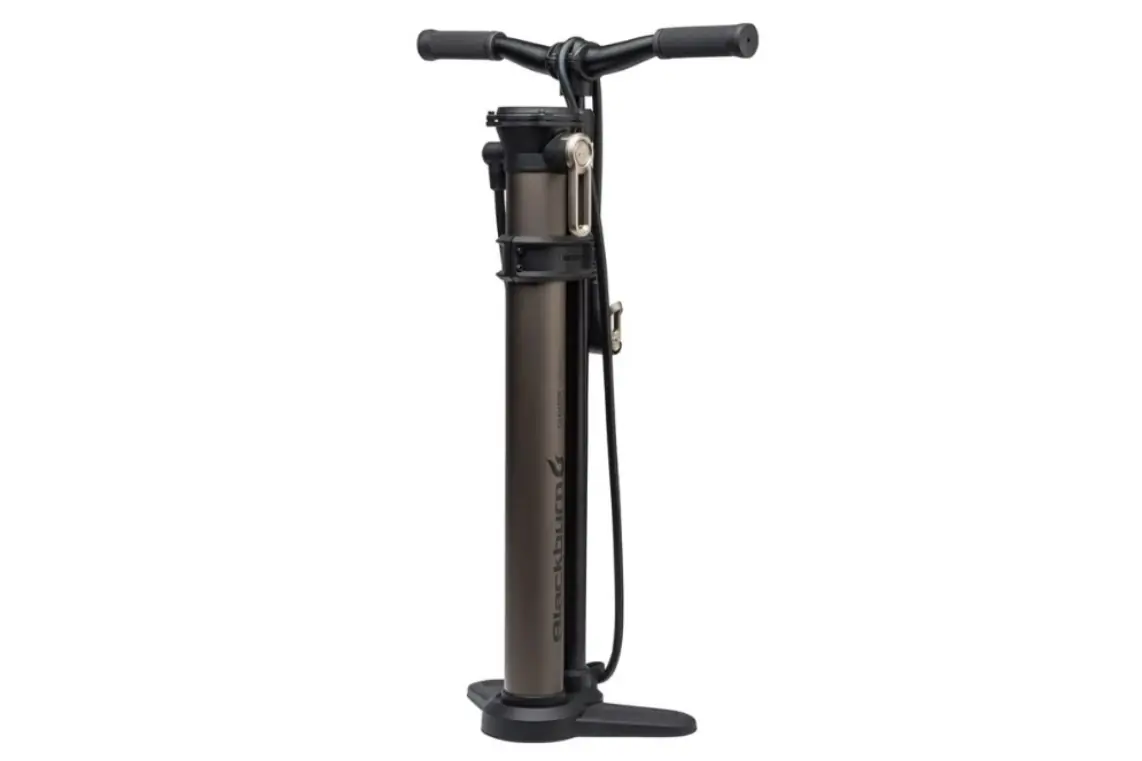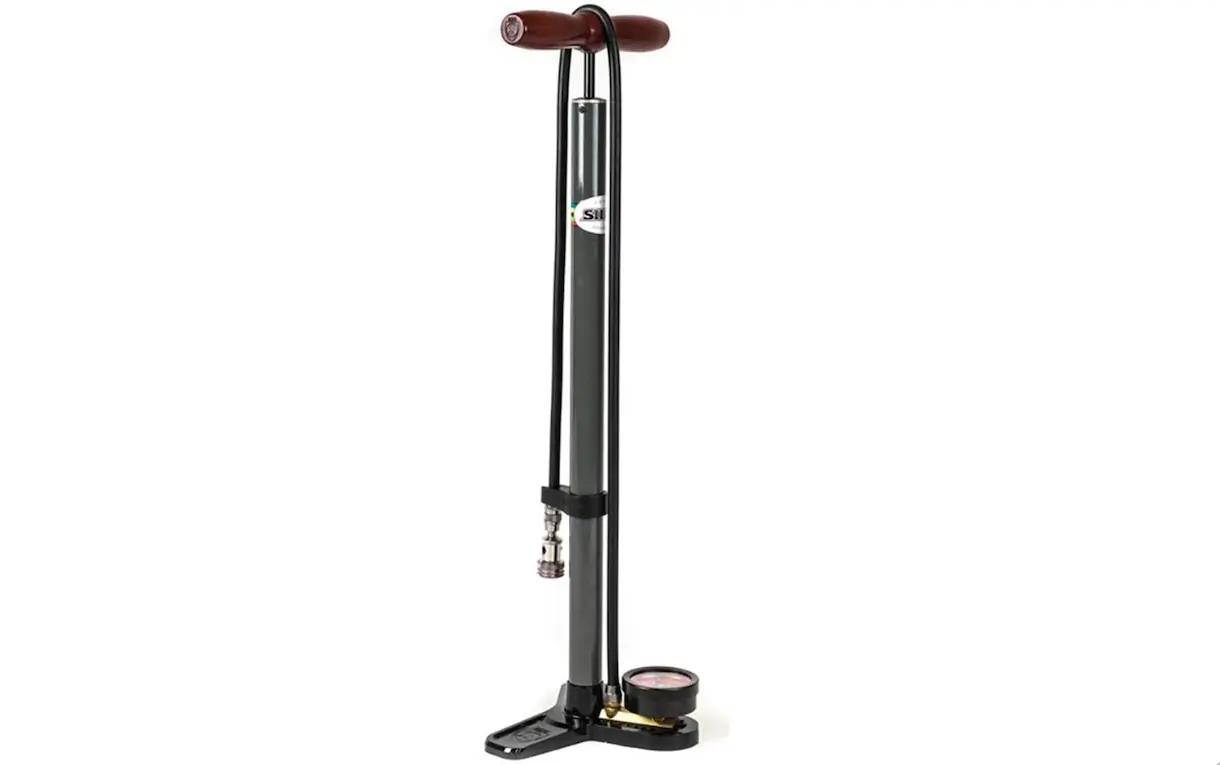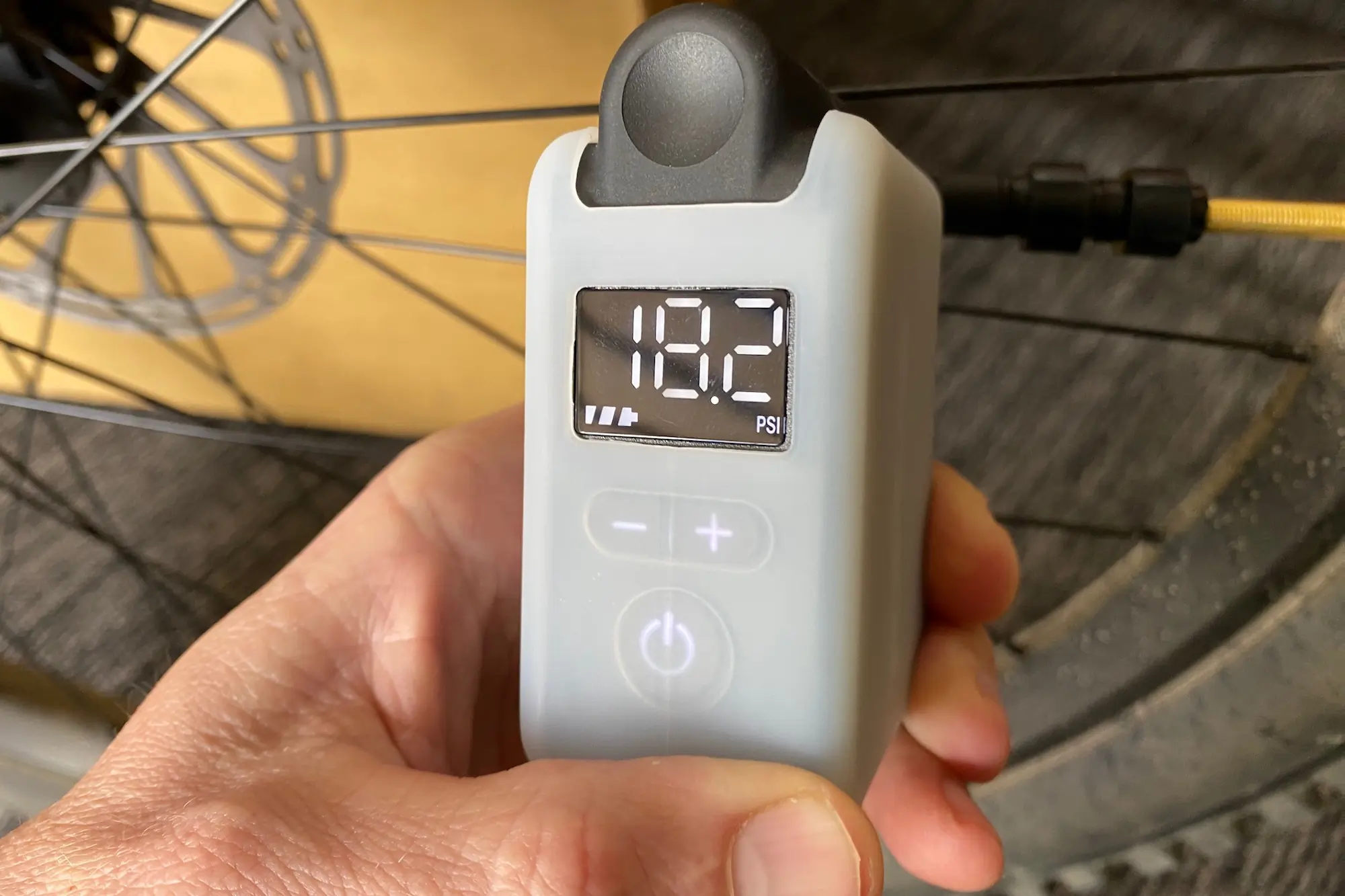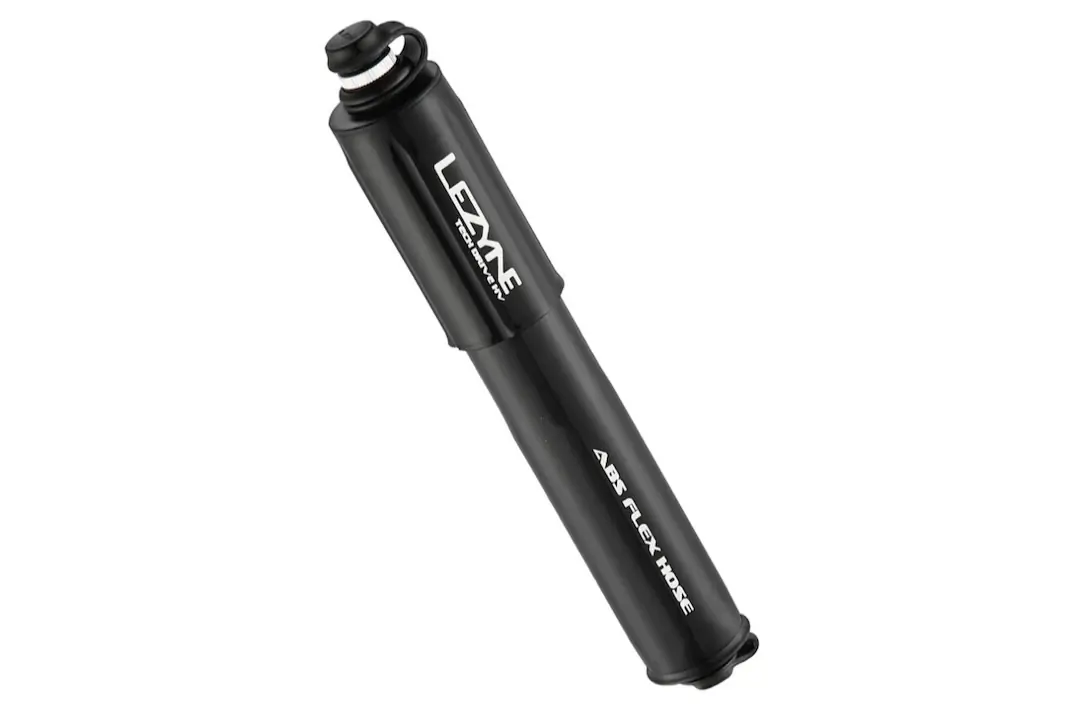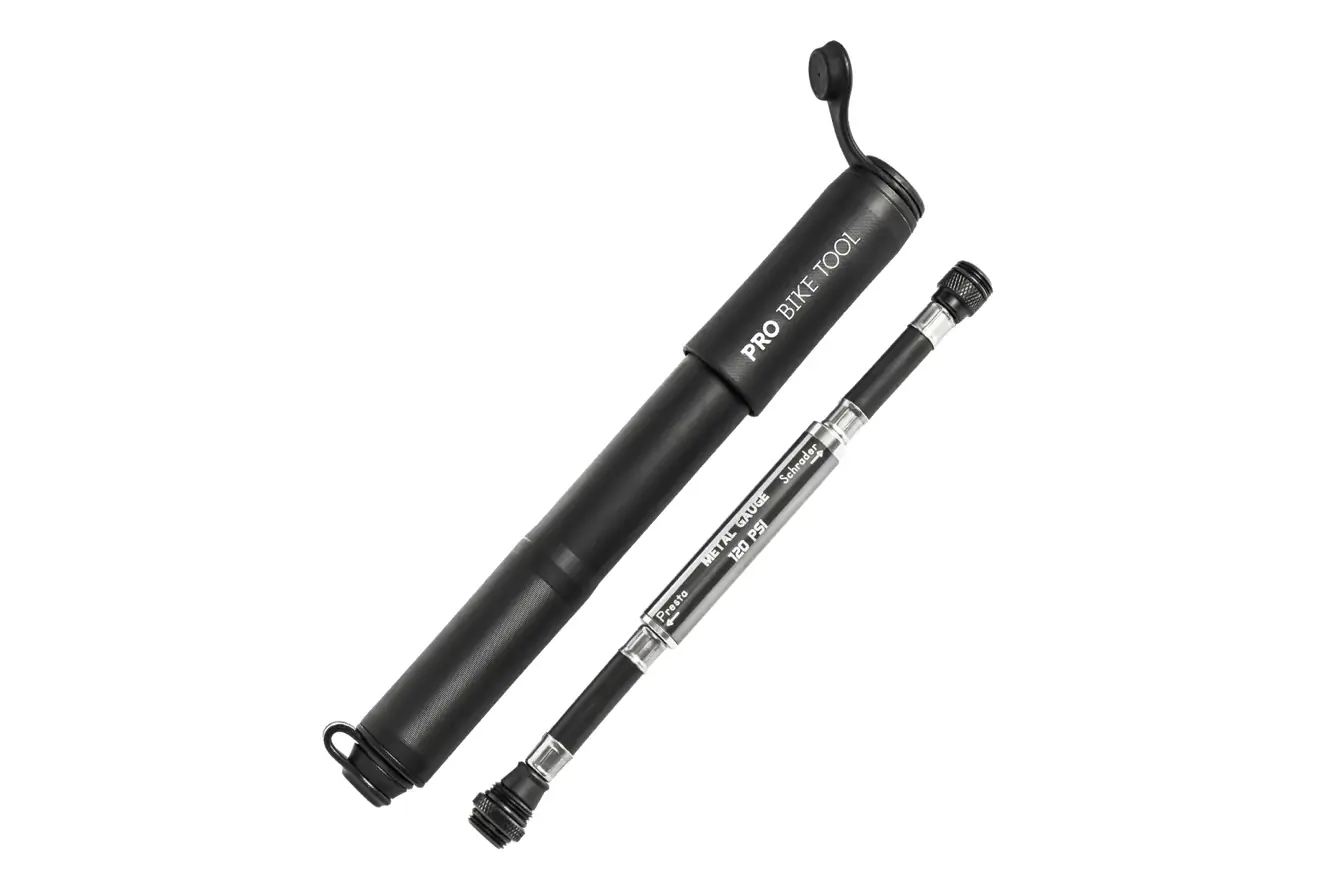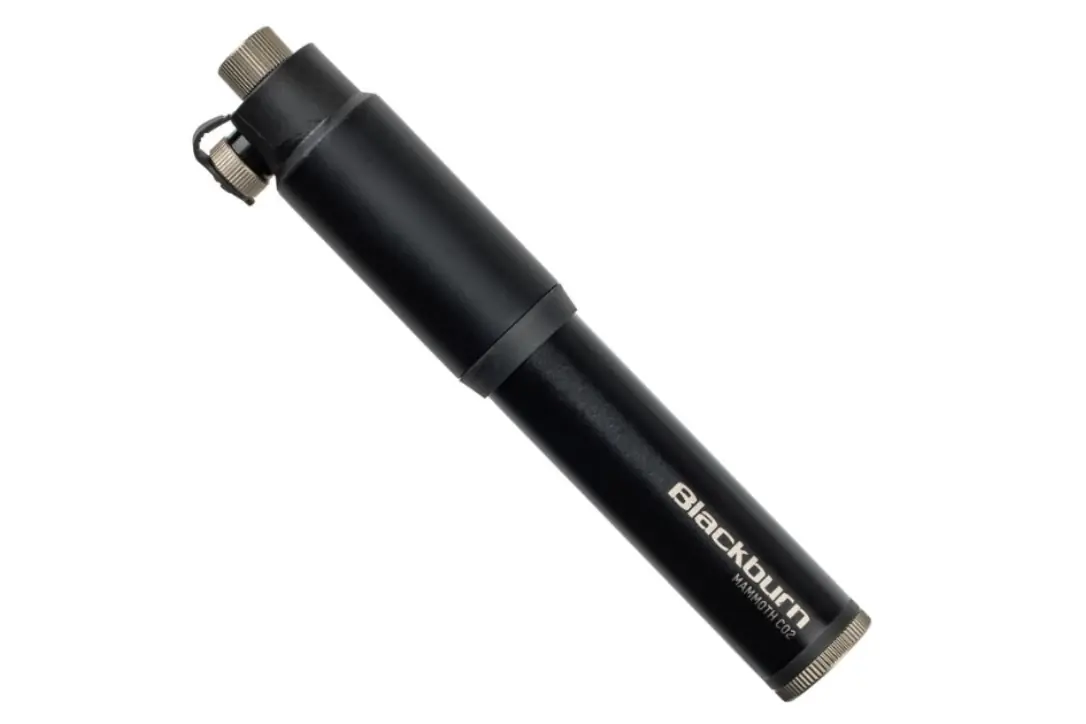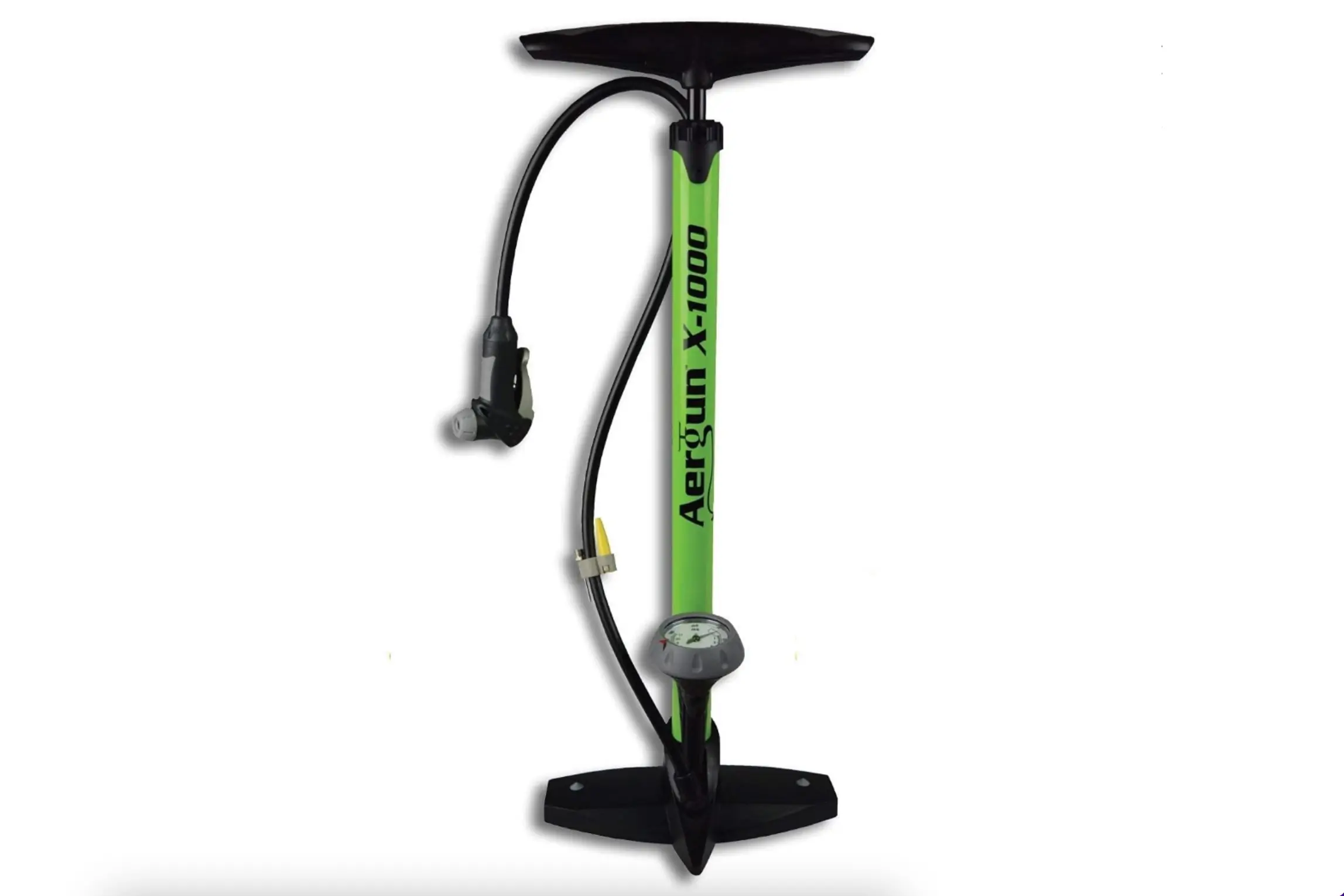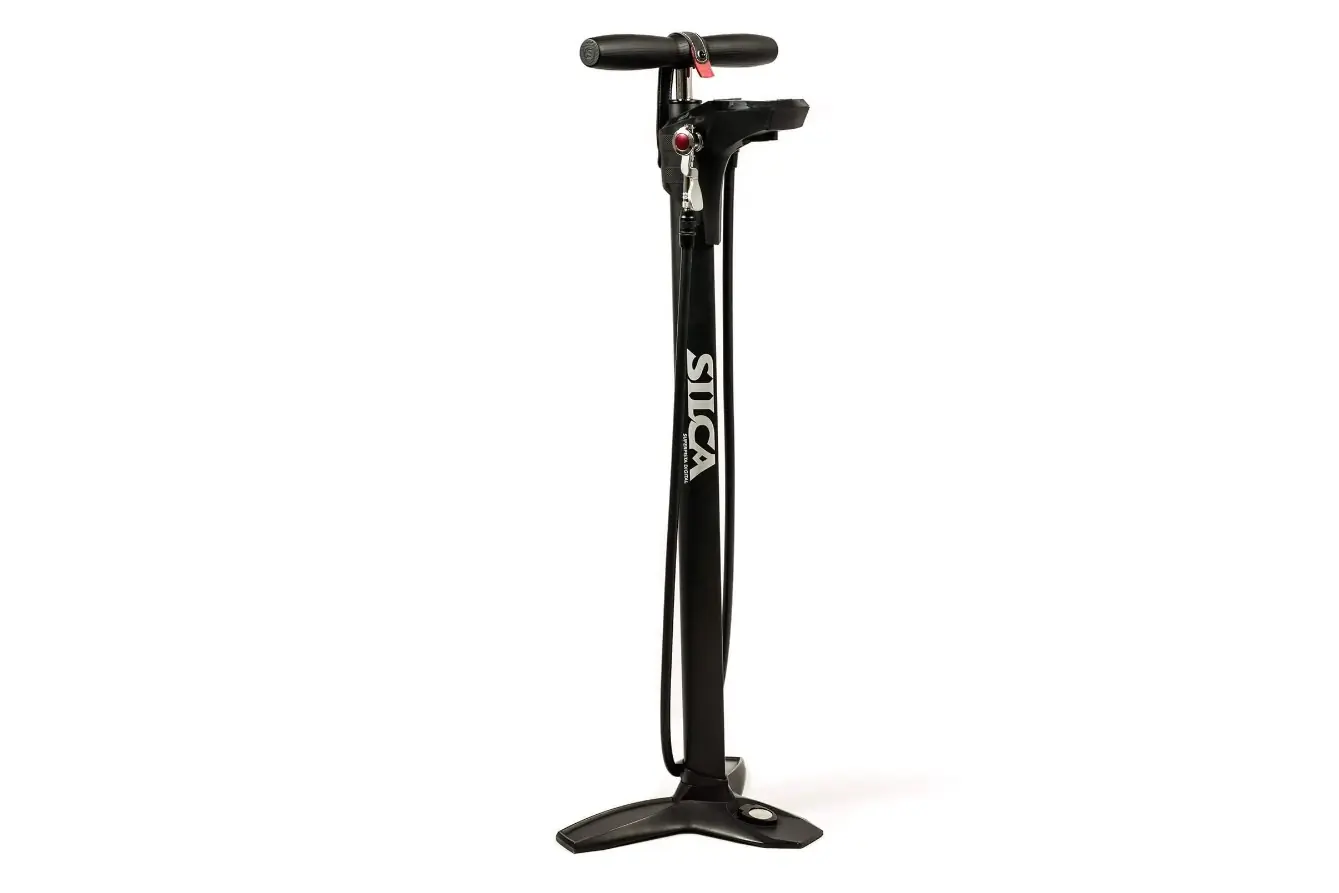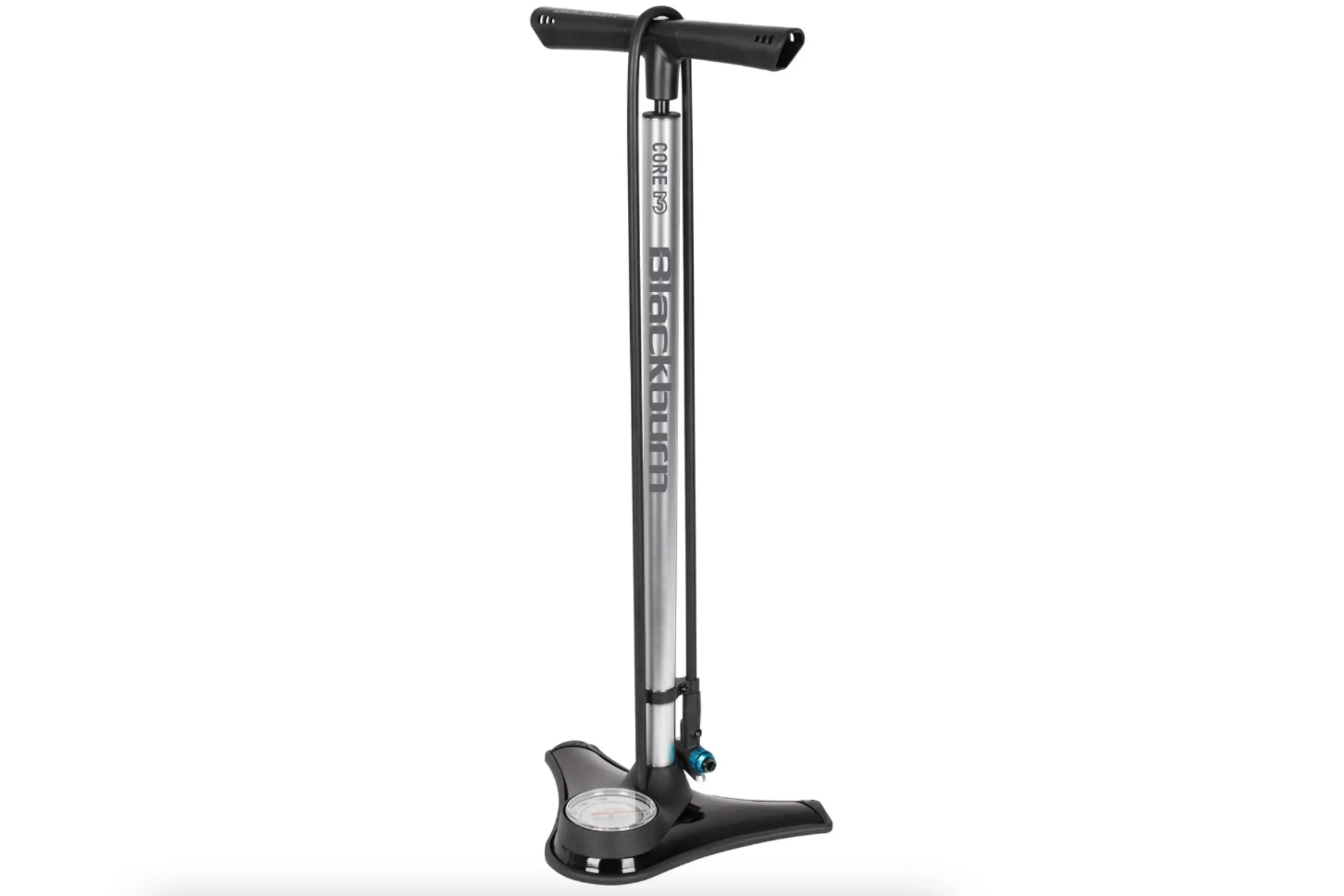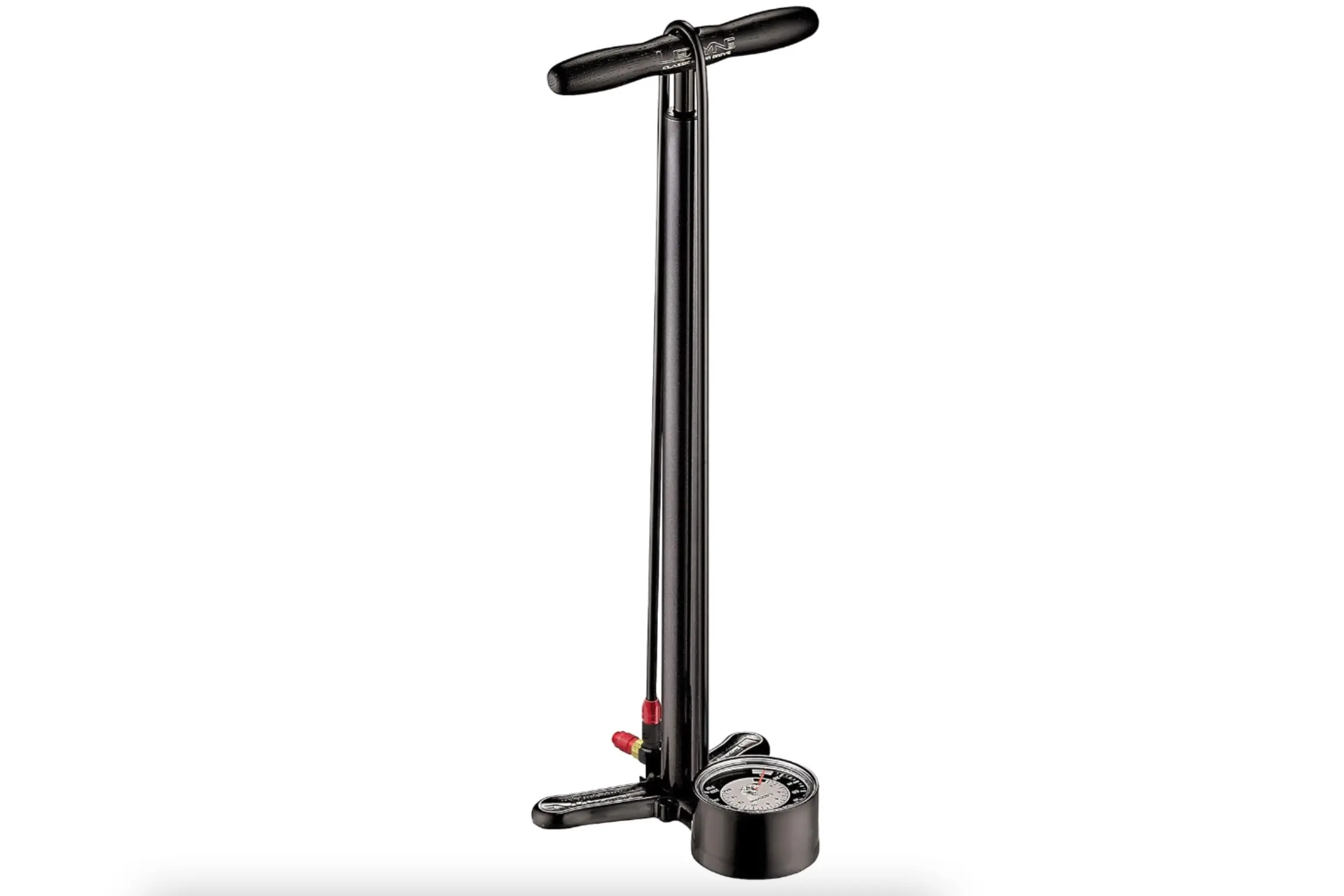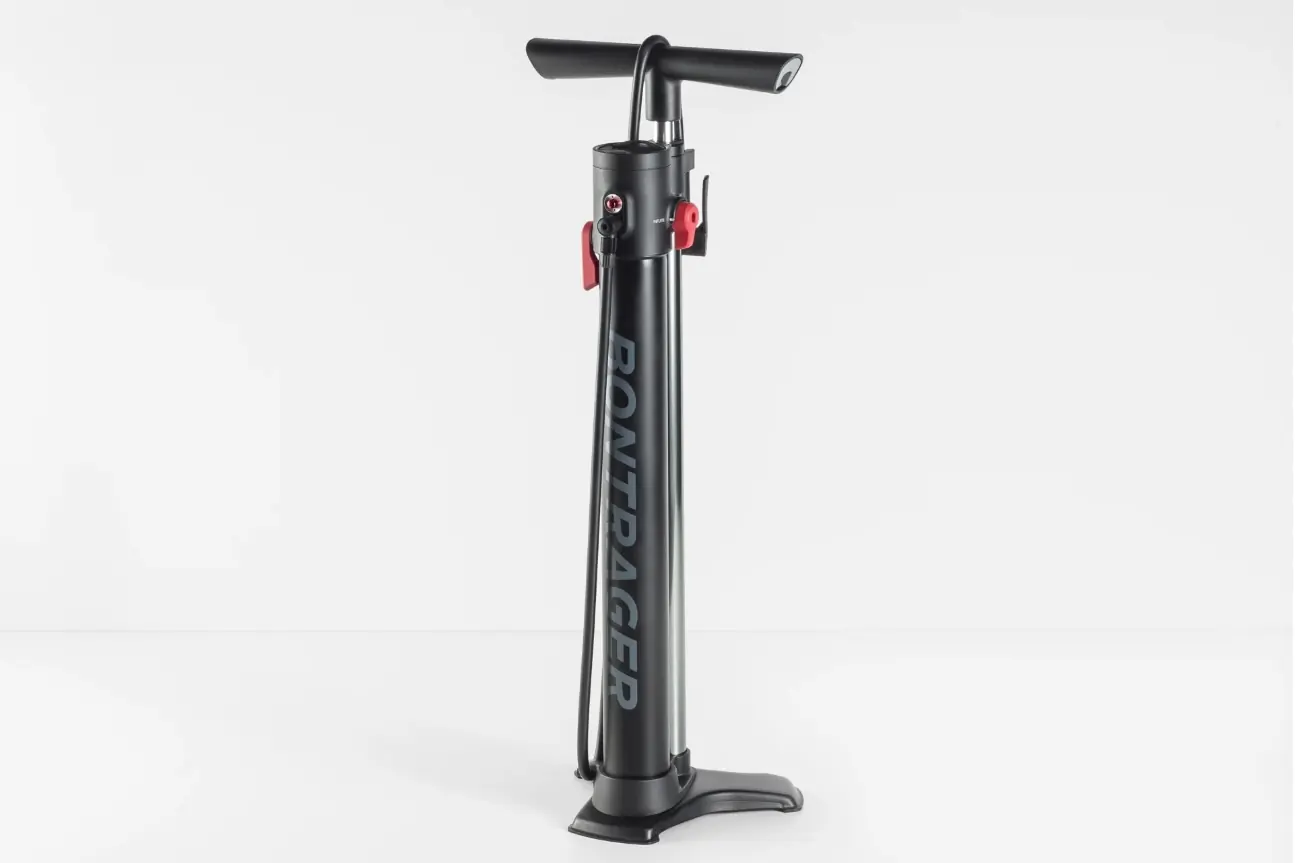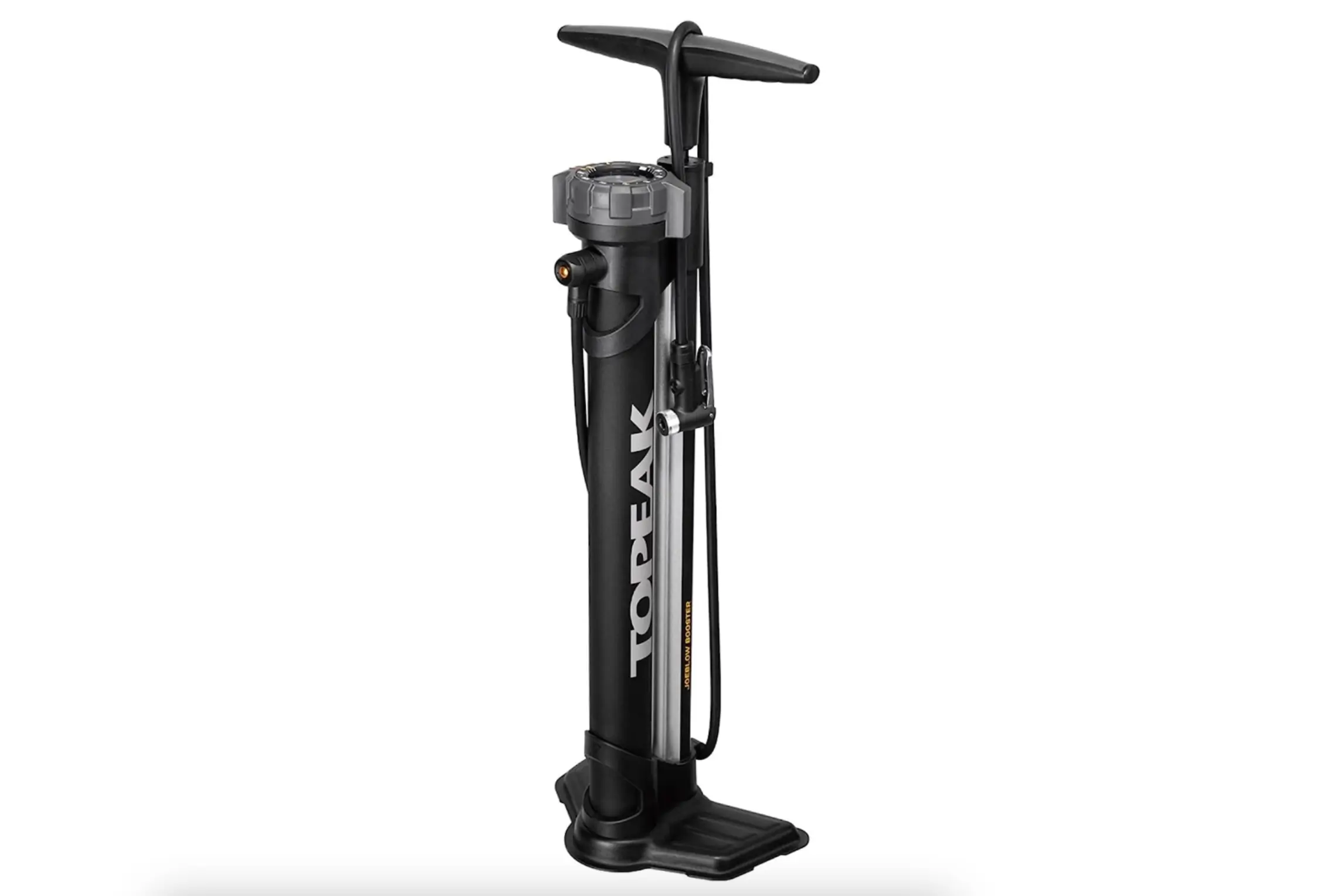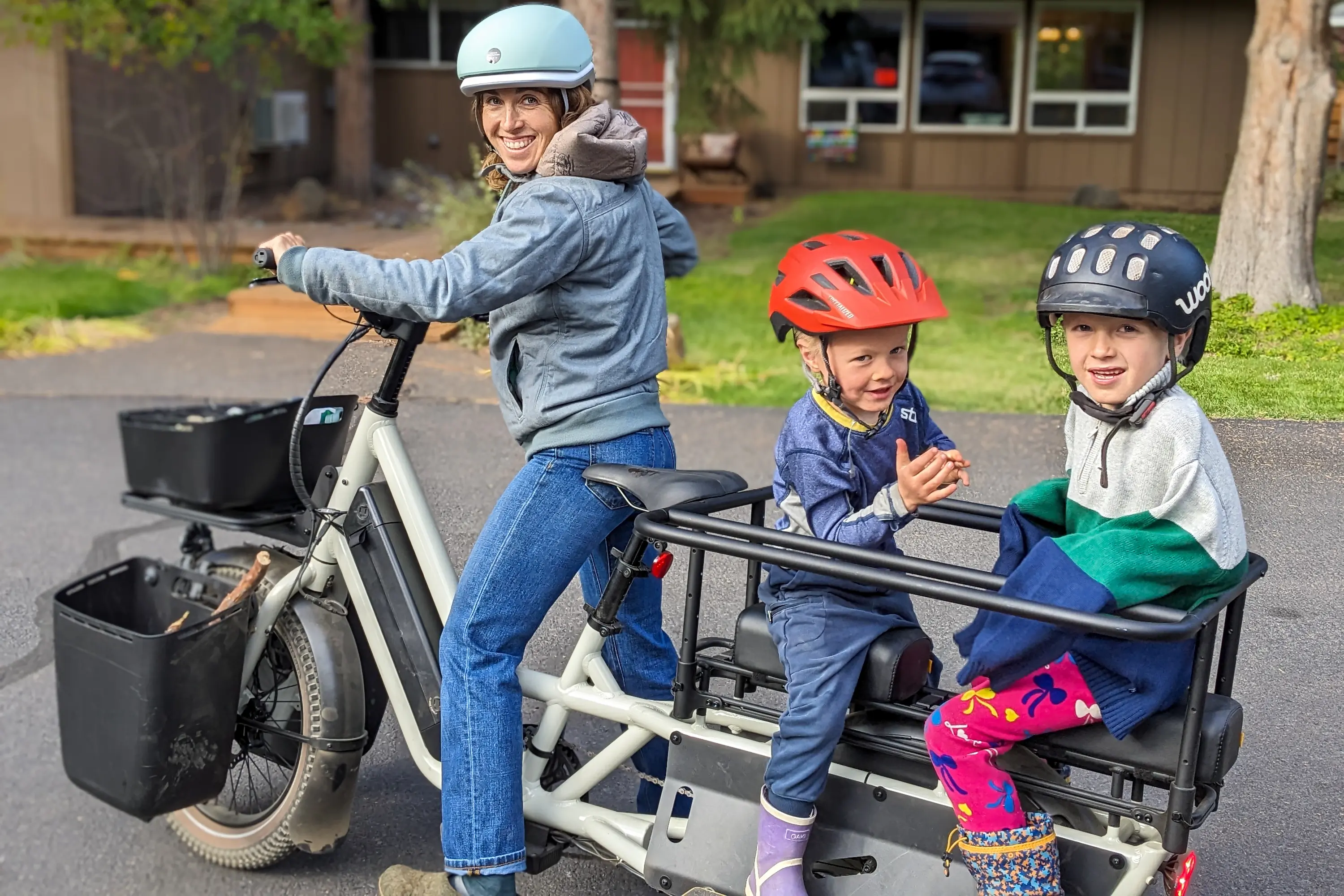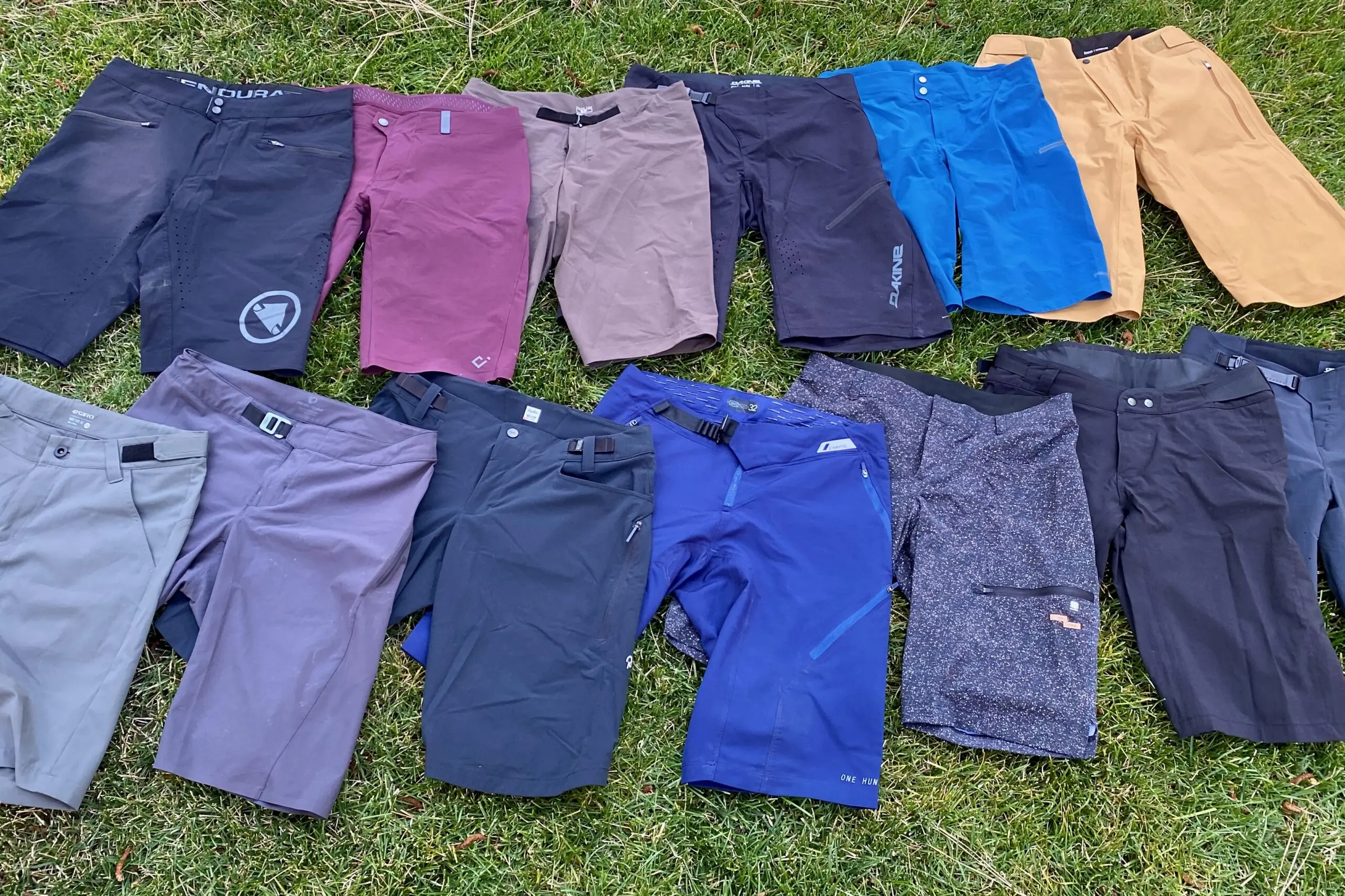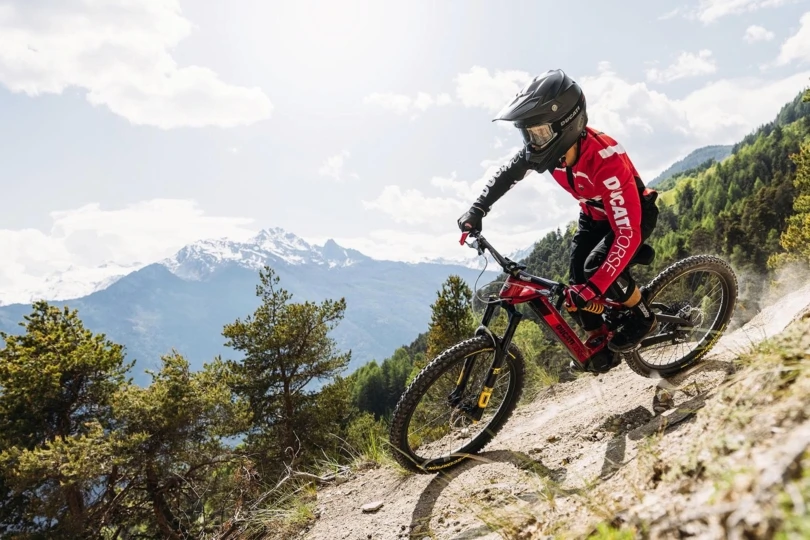Whether you ride road, gravel, mountain, or electric bikes, a good bike pump is a must-have for every cyclist. Maintaining the proper tire pressure is critical for comfort, safety, and the performance of your tires on the road or trails.
While they all perform the same basic task, there is a vast variety of pumps with literally hundreds of models to choose from. Whether for high volume, high pressure, seating tubeless tires, or carrying with you on rides, there are lots of great options to keep your bike rolling smoothly.
We rounded up 16 of the best pumps available today and have recommendations for all types of pumps and riders. Our diverse selection includes both high-end and budget-friendly models, high volume and high pressure, digital and analog gauges, and booster pumps for seating tubeless tires.
From the super-classic Silca Pista Plus to the budget-friendly Topeak Joe Blow Sport III, our top recommendations are listed below. And if you’re unsure what you need, our buying advice can help point you in the right direction.
Editor’s Note: We updated this guide for biking season on May 5, 2025, with the addition of the new Topeak E-Booster Digital, an electric mini-pump that fits in the palm of your hand.
The Best Bike Pumps of 2025
Bontrager Dual Charger
- Valves: Presta and Schrader all-in-one
- Max psi: 160
- Hose length: 46”
- Gauge: Analog
- Weight: 1,692 g
Pros
- Switch between high-volume and high-pressure easily
- Great efficiency in high volume mode
- Stable base
- Large, easy to read analog gauge
- Long hose
- Red color is easy to spot
Cons
- Average all-in-one head connection
- Head can be finicky
- Gauge is not the most accurate

ToPeak Joe Blow Sport III
- Valves: Presta and Schrader with two-sided head
- Max psi: 160
- Hose length: 30”
- Gauge: Analog
- Weight: 1,622 g
Pros
- Solid value
- Second most accurate gauge in our testing
- Smooth operation
- Durable
Cons
- Short hose length made less usable being mounted at bottom of pump
- Not the most stable
- Head is difficult to use with one hand
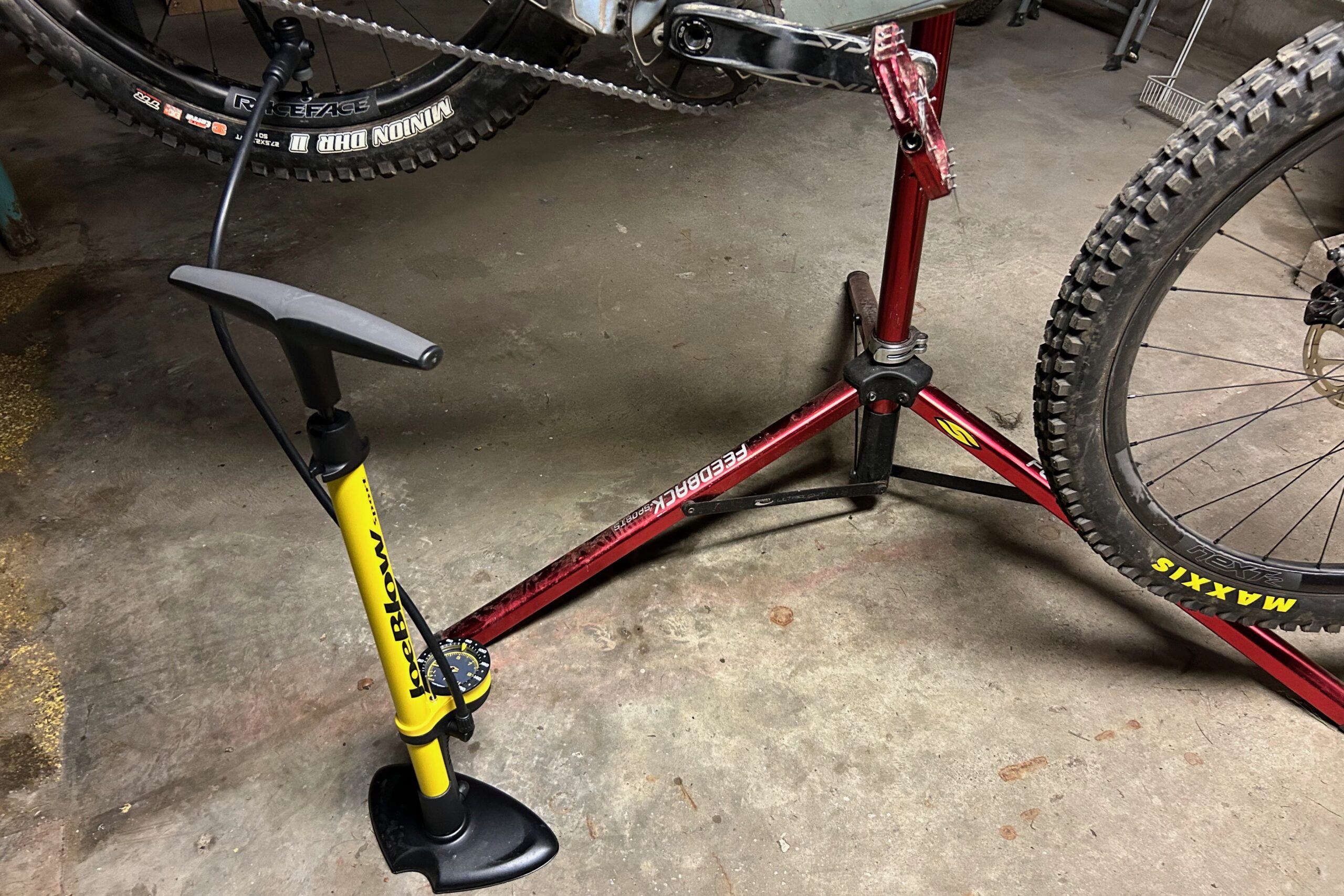
Blackburn Chamber Tubeless Floor Pump
- Valves: Presta and Schrader – flip-able head
- Max psi: 160
- Hose length: 62"
- Gauge: Analog
- Weight: 3,150 g
Pros
- Wide handle with mtb grips = better pumping ergonomics
- Seats tubeless tires with ease
- Dual function – regular pump and tubeless booster
- Durable construction
Cons
- Expensive
- Larger size and heavier weight
Silca Pista Plus
- Valves: Presta and Schrader
- Max psi: 120
- Hose length: 40" (102.5 cm)
- Gauge: Analog
- Weight: 1,575 g
Pros
- Very durable
- Powerful
- Accurate
- Beautiful
Cons
- Expensive
Topeak E-Booster Digital
- Valves: SmartHead, fits Presta and Schrader
- Max psi: 120
- Hose length: 2"
- Gauge: Digital
- Weight: Pump: 180 g, hose: 24 g, total: 204 g
Pros
- Works surprisingly well
- Compact size – fits in jersey pocket or pack
- Easy to use
- Preset pressure
- Faster than a hand pump
- Less waste than CO2 canisters
Cons
- Expensive
- Heavier than advertised
- Fairly loud
Lezyne Tech Drive HV
- Valves: Presta and Schrader
- Max psi: 90
- Hose length: 6"
- Gauge: None
- Weight: 131 g (medium)
Pros
- Longer flex hose for easy valve access
- Light weight
- Moves a good volume of air
- Fair price
Cons
- Not great for high pressure applications
- Medium size we tested is fairly long and bulky
- Valves: Reversible Presta and Schrader
- Max psi: 100
- Hose length: 7"
- Gauge: Analog in-line
- Weight: 128 g
Pros
- CNC aluminum construction
- Integrated hose with gauge
- Included bike frame mount
- Affordable
Cons
- Gauge limits hose flexibility
Other Bike Pumps to Keep Your Tires Inflated
- Valves: Presta
- Max psi: Not specified
- Hose length: 3"
- Gauge: None
- Weight: 134 g
Pros
- Mini-pump and CO2 inflator in one
- Compact size – fits in a jersey pocket
- Light weight
- Good for higher volume applications – MTB and gravel
Cons
- Doesn't work with Schrader valves
- Not great for high-pressure pumping
- Valves: Reversible locking, fits Presta and Schrader
- Max psi: 100
- Hose length: 3.5"
- Gauge: None
- Weight: 165 g
Pros
- Ultra-compact design
- Hidden air hose
- Integrated heat sinks
Cons
- Not the easiest to mount to bike frame
- Expensive
- Valves: Presta and Schrader all-in-one
- Max psi: 160
- Hose length: 34"
- Gauge: Analog
- Weight: 1,090 g
Pros
- Very affordable
- Gets the job done
- Easy to use
- Versatile all-in-one head
Cons
- Shorter hose length
- Not the most stable footing
- Less robust build
- Valves: Presta with Hiro chuck, threaded Schrader
- Max psi: 220
- Hose length: 48”
- Gauge: Digital
- Weight: 1,967 g
Pros
- Hiro chuck works great – easy to use with one hand
- Quality construction
- Supple hose
- Very stable footing with rubber feet
- Digital gauge works great
- Replaceable and rebuildable components
- Extremely smooth pumping action
Cons
- Preload function is not very valuable
- Average accuracy at a high price point
- Fabric handle clasp is very tight
- Extremely expensive
- Valves: Presta and Schrader reversible head
- Max psi: 160 (11 bar)
- Hose length: 50” (127cm)
- Gauge: Analog
- Weight: 1,580 g
Pros
- Good value
- Stable and wide, rubber footed base
- Smooth feel
- Lifetime warranty
- Sturdy, durable construction
Cons
- Not our favorite head lock design, awkward operation and very stiff
- Valves: Presta and Schrader all-in-one
- Max psi: 220
- Hose length: 47”
- Gauge: Analog
- Weight: 1,500 g
Pros
- All-in-one head is easy to use and has a good, sturdy feel
- Relatively efficient
- Easy to read analog gauge with clear color differentiation between high-volume and high-pressure readings
- Greater gauge detail between 0-40 psi
- Metal handle feels solid
- Smooth pumping action
Cons
- Stand is not the most stable in the test
- No rubber padding on bottom of metal foot
- Gauge only goes up to 140 psi
- Valve: Presta and Schrader thread-on
- Max psi: 220
- Hose length: 46"
- Gauge: Analog
- Weight: 1,885 g
Pros
- Slim/sleek
- Does the job
- Fully serviceable
- Moderate price
Cons
- Screw-on valve is less user-friendly
- Valves: Presta and Schrader all-in-one
- Max psi: 160 (11 bar)
- Hose length: 54” (137cm)
- Gauge: Digital
- Weight: 3,002 g
Pros
- Very accurate gauge
- Fast enough airflow to almost fully seat tubeless tires
- 54” hose length increases usability and plays nicely when the bike is on a stand
- Digital gauge is easy to read and repeatable
- Pin and plug hidden in handle
Cons
- Less efficient than a normal floor pump
- Challenging to increase reservoir pressure above 125 psi
- Average all-in-one head connection
- Valves: Presta and Schrader all-in-one
- Max psi: 160
- Hose length: 60”
- Gauge: Analog
- Weight: 3,387 g
Pros
- 60” hose is plenty long
- Simple operation to release reservoir
- Generally easy to use
- Stable
Cons
- Expensive
- Head has a very sloppy feel, loose and gets knocked off easily
- Challenging to fill reservoir fully to 160 psi
- Airflow from reservoir is not quick enough to seat tubeless tires reliably
- Not super efficient
Best Bike Pumps Comparison Chart
| Bike Pump | MSRP | Valves | Max PSI | Hose Length | Gauge | Weight |
|---|---|---|---|---|---|---|
| Bontrager Dual Charger | $80 | Presta/Schrader all-in-one | 160 | 46″ | Analog | 1,692 grams |
| ToPeak Joe Blow Sport III | $60 | Presta/Schrader two-sided | 160 | 30″ | Analog | 1,622 grams |
| Blackburn Chamber Tubeless | $200 | Presta and Schrader | 160 | 62″ | Analog | 3,150 grams |
| Silca Pista Plus | $199 | Presta and Schrader | 120 | 40″ | Analog | 1,575 grams |
| Topeak E-Booster Digital | $130 | Presta/Schrader all-in-one | 120 | 2″ | Digital | 204 grams |
| Lezyne Tech Drive HV | $45 | Presta and Schrader | 90 | 6″ | None | 131 grams |
| Pro Bike Tool High Pressure Mini | $37 | Presta and Schrader | 100 | 7″ | Analog in-line | 128 grams |
| Blackburn Mammoth CO2 Mini-Pump | $55 | Presta | Not specified | 3″ | None | 134 grams |
| Silca Tattico Mini-Pump | $70 | Presta and Schrader | 100 | 3.5″ | None | 165 grams |
| AerGun X-1000 | $40 | Presta/Schrader all-in-one | 160 | 34″ | Analog | 1,090 grams |
| Silca SuperPista Digital | $349 | Hiro Presta and thread-on Schrader | 220 | 48″ | Digital | 1,967 grams |
| Blackburn Core 3 | $80 | Presta/Schrader reversible | 160 | 50″ | Analog | 1,580 grams |
| Pro Floor Pump Team | $120 | Presta/Schrader all-in-one | 220 | 47″ | Analog | 1,500 grams |
| Lezyne Classic Floor Drive 3.5 | $80 | Presta/Schrader ABS-1 Pro Chuck | 220 | 46″ | Analog | 1,885 grams |
| Bontrager TLR Flash Charger | $175 | Presta/Schrader all-in-one | 160 | 54″ | Digital | 3,002 grams |
| ToPeak Joe Blow Booster | $220 | Presta/Schrader all-in-one | 160 | 60″ | Analog | 3,387 grams |
How We Tested Bike Pumps
Our team of cycling testers and editors ride bikes, a lot. For work, play, training, racing, you name it — our lives revolve around bikes of all kinds. With all that riding comes a lot of tires, and we are constantly using bike pumps to install or add air to tires on our townies, road, gravel, and mountain bikes. Turns out, the lowly bike pump is one of the most frequently used and important tools any of us have.
We also know that finding the right bike pump can be a challenge, and we are always in search of the best models to make our lives easier while keeping our tires at the perfect pressure for optimal performance.
Our Expert Testers
For our bike pumps buyer’s guide, we enlisted contributor Paul Clauss to test and compare the majority of the models in this review. Paul is an avid cyclist who lives in northern Vermont, where he spends the majority of his time on his mountain bike and his gravel bike/commuter. He enjoys technical trail riding and knows the importance and benefits of a properly inflated tire and its relation to his enjoyment and performance on the trail.
A mechanical engineer by trade, Paul loves to tinker with things, scrutinize designs, and perform quantifiable tests to help him discern differences in the performance of the products he tests. In addition to bike pumps, Paul has tested dropper seatposts, the best flat pedal shoes, secure bike locks, and bike repair stands.
Contributor Bennett Shane brings additional expertise to this guide. Bennett is an avid road cyclist who has tested hundreds of pieces of cycling gear in the past year. He’s a stickler for the perfect setup and optimal pressure to ensure he gets maximum comfort and control out of his road bike tires. In addition to testing bike pumps, Bennett has tested dozens of the best road bike tires, protective road bike helmets, cycling bib shorts, and road bike pedals.
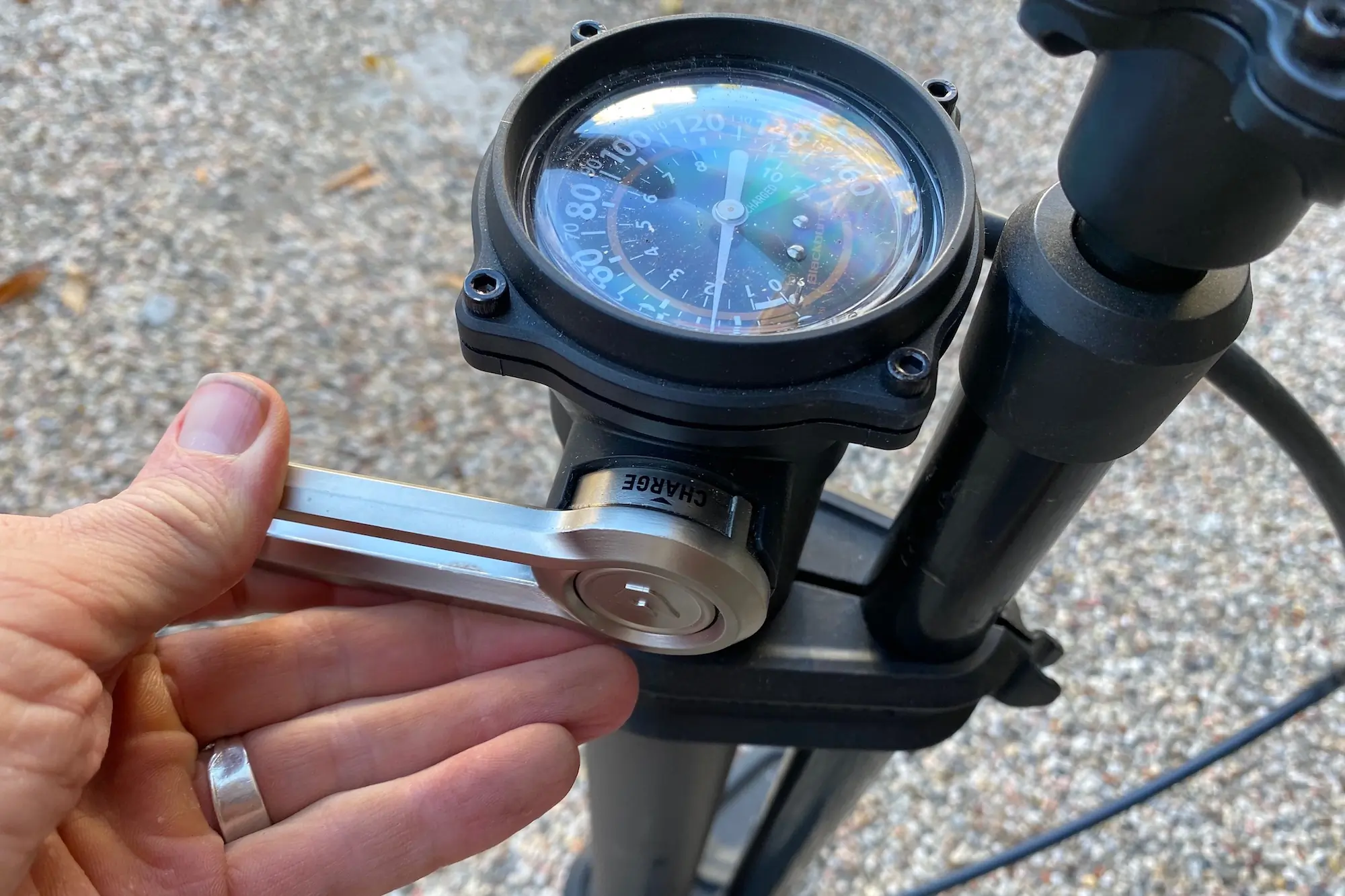
Our Testing Process
After rounding up a diverse selection of the best bike pumps on the market in 2025, we ran each model through the same rigorous testing process to evaluate their strengths, weaknesses, and performance differences. While some of these pumps have been in a staff member’s garage for years, we tested them all over the course of several weeks, rotating through them for every day pumping needs.
Each model was also used for a number of repeatable tests in search of quantifiable results. These included checking gauge accuracy at 10 psi intervals against our ToPeak SmartGauge D2X digital pressure gauge, as well as a pumping efficiency test to determine the number of strokes needed to inflate a Maxxis Minion DHR II to 30 psi.
During these tests, we evaluated the ease of use and security of valve chucks/heads, stability in use, comfort of handles, smoothness of the pumping action, and readability of gauges. The more specialized pumps were tested for their intended uses of seating tubeless tires or adding air to suspension components. When testing concluded, we zeroed in on our favorites and those that excel for specific reasons compared to the rest.


Buying Advice: How to Choose the Best Bike Pump
When choosing a bike pump, there are several factors to consider that may impact your purchase decision. A major factor is the type of tires you need to inflate along with the type of pump, type of valves (and valve attachment method), the volume of air moved per stroke of the pump (the efficiency of the pump), the gauge accuracy, and the overall build quality and stability of the pump. We’ll provide more detail on each of these areas below.
Bike Pumps are great for regularly topping off your tire pressure, but you’ll also want to learn how to change a tire if you don’t already know.
Types of Bike Pumps
The review focuses primarily on floor pumps, which are aptly named for their ability to stand up and be used on the floor in your workshop (or parking lot at a trailhead). We tested three different types: standard floor or track pumps, tubeless booster pumps, and a high-pressure shock pump. Portable options like hand pumps, frame pumps, and CO2 inflators are other common tools for adding air to tires, though they are typically reserved for use in the field.
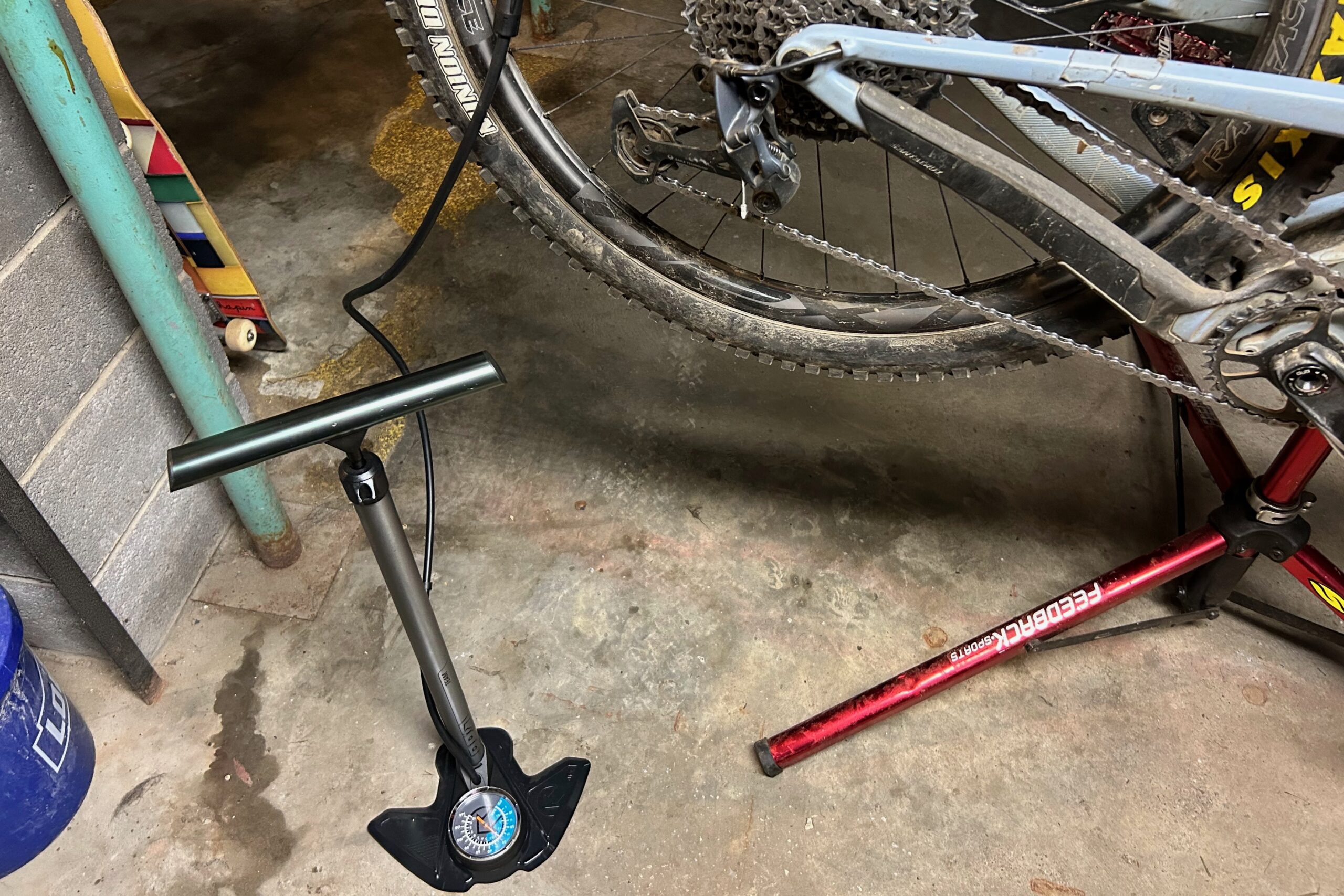

Standard Floor Pumps or Track Pumps
Standard floor pumps, also known as track pumps, transfer air directly from the pump to the tire through the valve. If you’ve ever used a bicycle pump, chances are you’ve used a standard floor pump. They can be used with all types of tires and wheel.
While standard floor pumps are not as effective for mounting tubeless tires as an air compressor or reservoir-style pump (in theory), they can often get the job done, especially if the tire has a relatively snug fit on the rim, or you have prior experience and good technique. We like to keep our in a very easy-to-access location, preferably near our favorite chain lube and a rag for the pre-ride bike check.
Standard floor pumps are often optimized to work better for high-volume/low-pressure or high-pressure/low-volume applications. High-volume pumps typically move more air per pump, making them well-suited to inflating the larger volume of lower-pressure mountain bike tires.
High-pressure pumps generally move less air per pump but are better suited to inflating lower-volume tires, like those on road bikes, to higher pressures. Either style of pump still works for all types of tires. Some pumps are capable of performing both tasks and are equipped with switches to change between high-volume and high-pressure pump settings, like the Bontrager Dual Charger.


Tubeless Booster Pumps
Tubeless booster pumps are very similar to standard floor pumps but include a reservoir that can be pumped up to a high pressure and then quickly released. Tubeless pumps strive to act as small manual air compressors to make tubeless setup easy. Quickly releasing high air volumes helps “snap” the bead of tubeless tires to seat them on the rim.
They also function as regular pumps for everyday use, making them a versatile addition to the home workshop for those who change their tubeless tires frequently. The Bontrager TLR Flash Charger, Blackburn Chamber, and the ToPeak Joe Blow Booster are the three models of this style that we tested, although there are a few other options on the market as well.
As tubeless tires have grown in popularity and are now widely used not only on mountain bikes but also gravel and road, tubeless pumps are becoming increasingly common. While the models we tested certainly helped make tubeless setup easier, it isn’t always necessary to use one for tubeless tire installation. One thing that is necessary, however, is using tubeless tire sealant.
Some tubeless tires can easily be installed with a standard pump, depending on the tire brand/model and the rim combination. Other tubeless tires can be more stubborn, and that’s where the Booster pumps come in handy. It is worth noting that pumping the reservoirs on these pumps up to 160 psi can be somewhat challenging, especially when you get above 120 psi.
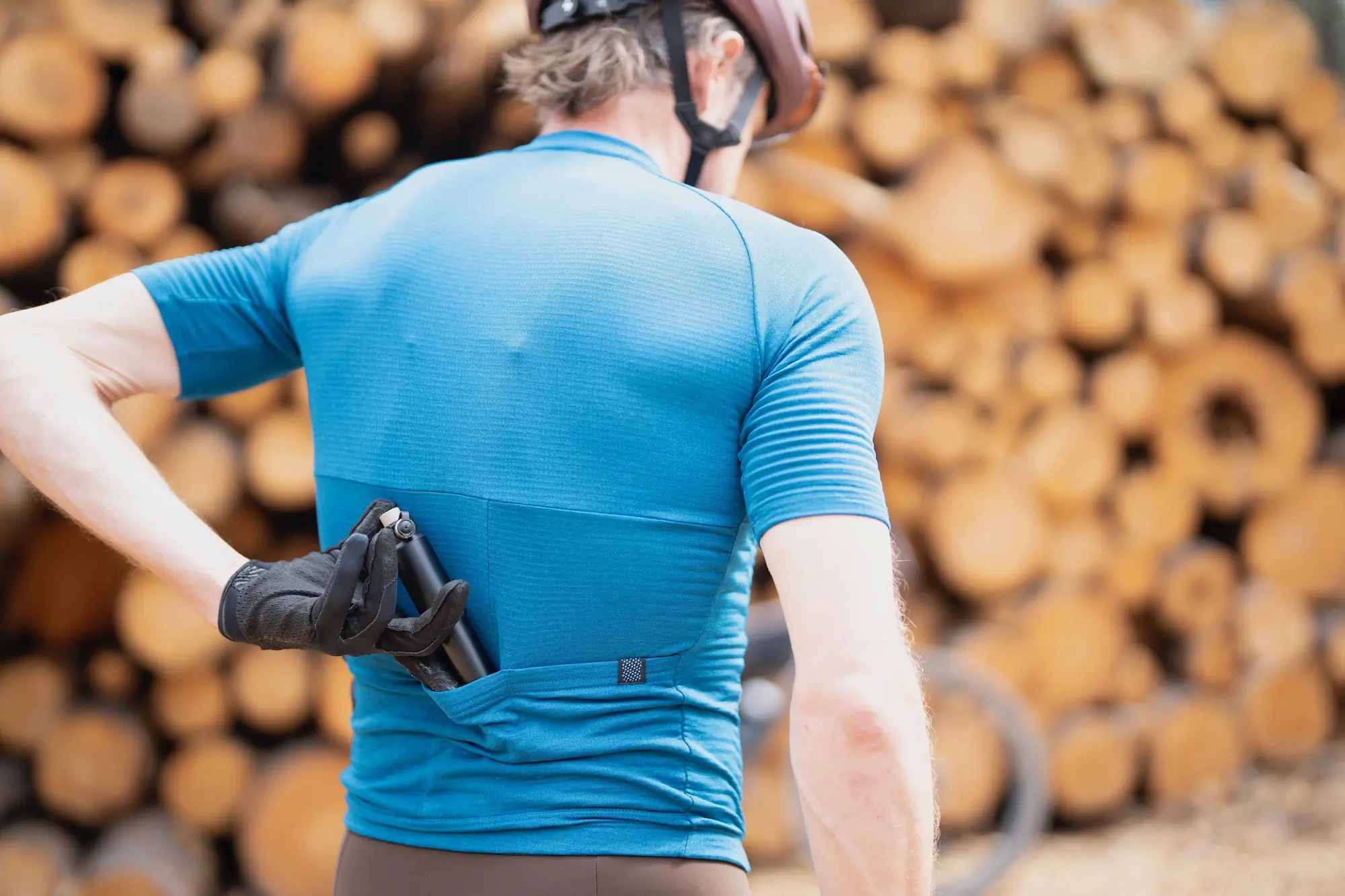



Mini-Pumps
When you’re out on the road or trail, it’s always a great idea to carry a quality bike multi-tool and have some sort of way to help inflate your tires if you get a flat. Mini-pumps, also called hand pumps or frame pumps, are a great option that can usually be attached to your bike or stashed in a hydration pack or jersey pocket to take along with you.
Their portability requires smaller bodies, which means far less volume per pump than floor pumps, making it longer to fill a tire than a floor pump. Even though it takes longer, they are still an indispensable tool to have with you when the need arises.
When referring to mini-pumps, the speed of inflation depends largely on how easy it is to use. Look for a mini-pump with a solid grip, as your hands will be doing most of the work. A mini-pump with textured handles or knurling machined onto the grip will work well to maintain a solid hold.
Guaranteeing a tight seal between the hose and valve is also a factor. A good screw-on hose head can minimize the loss of air when you pump. This reduces the number of pumps (and the time) that it takes to fill your tire. We feature four mini-pump models in our list above, the Lezyne Tech Drive HV, Silca Tattico, Blackburn Mammoth CO2, and the Pro Bike Tool High Pressure Mini, all of which are fine options to bring along on your rides. The Blackburn mini-pump also has an adaptable head that doubles as a CO2 inflator, which is quite convenient.
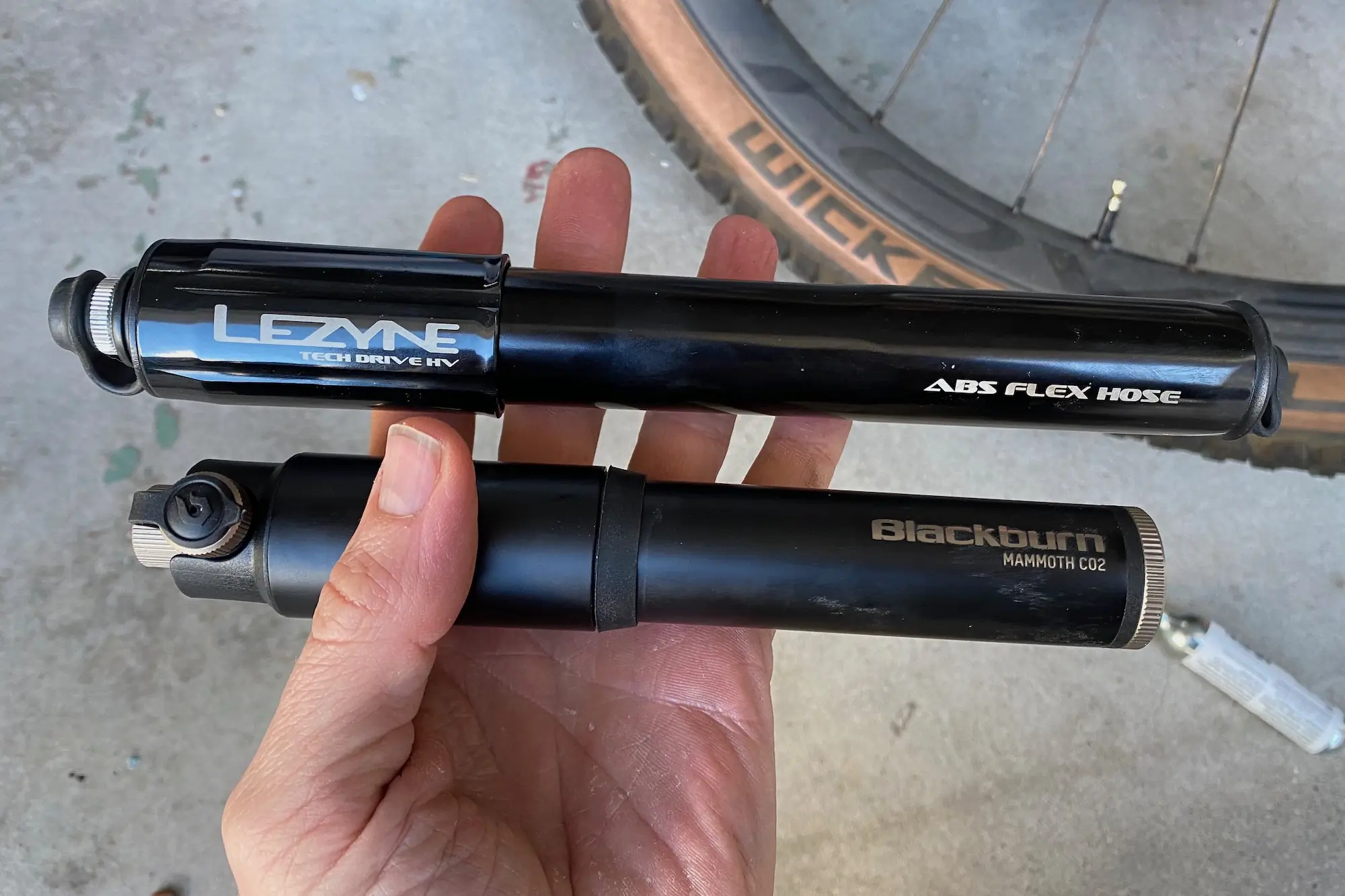



Electric Pumps
Battery and electric motor technology have been evolving rapidly, and several small electric compressors have recently hit the bike pump market. These compact units are small enough to fit in the palm of your hand, so they are easy to stash in a jersey pocket or hydration pack to bring with you on rides.
Unlike a mini-pump, these mini air compressors do the pumping for you, saving you lots of time and effort. These rechargeable electric pumps can be used multiple times on a charge and can potentially save you money and waste compared to using CO2 cartridges. We tested the Topeak E-Booster Digital and were blown away by its ease of use and pumping performance.
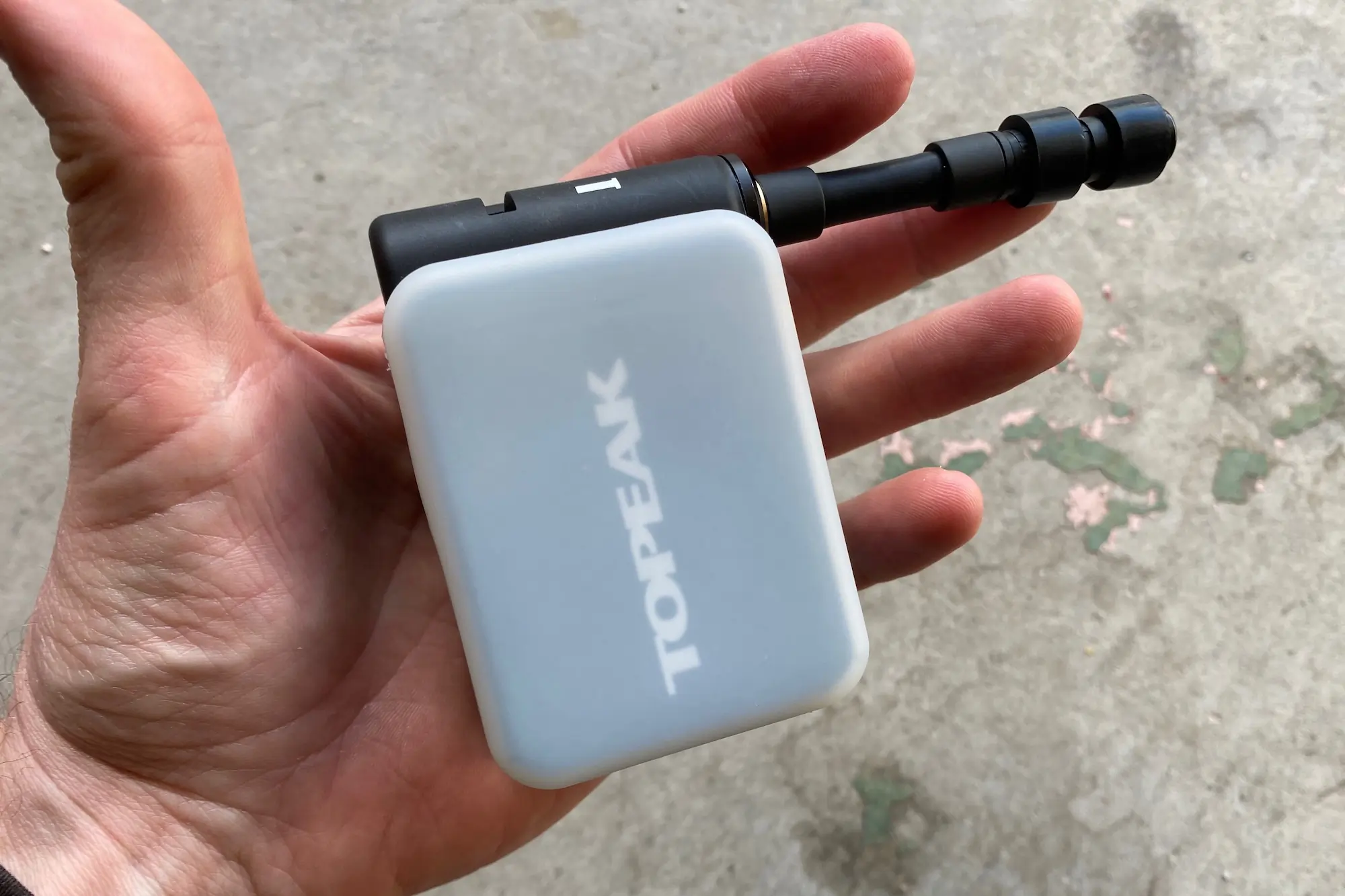



Shock Pumps
Shock pumps are more of a niche product for those who work on or adjust their mountain bike suspension components regularly. The air chambers of suspension forks and rear shocks are quite small, and they generally need to be inflated to significantly higher pressures than tires. For this reason, shock pumps move smaller volumes of air but are typically capable of reaching much higher pressures.
A great example of a shock pump is the Specialized Air Tool UHP, which has a threaded Schrader head that attaches to shocks and forks and has a max psi of 350.
While most people use small hand-held shock pumps at home or on the trail, a standing model like the Specialized Air Tool makes adding air to suspension components much quicker and easier. These are most common in bike shops, but those who tinker with or service their own suspension at home can benefit from them as well.


Types of Valves
Bike tube/tire valves will almost always be either Presta or Schrader. There is a third valve type, known as Dunlop valves, though they are fairly uncommon in this day and age. Schrader valves are like those found on your vehicle, and they are larger in diameter and generally found on more value-oriented or electric commuter bikes.
Presta valves are most common among higher-end road/mountain bikes. Most tubeless valves are Presta valves, though there are some Schrader options available. Both types of valves have been around for quite a while, and every pump we tested has configurations that work with both Presta and Schrader valves.


Valve Chucks/Connections/Heads
While all the pumps in our test group accommodate both Presta and Schrader valves, they do so in different ways. Some pumps have heads that thread onto the valve, while others have lever-lock style heads that tighten on the valve when the lever is flipped. Many pumps use an all-in-one head style, which easily connects to either Presta or Schrader valves but tends to be more sensitive to angular changes and can leak a bit more when being put on or taken off.
Other pumps, like the Silca SuperPista Digital, use a removable chuck for Presta valves that threads onto a Schrader connection directly on the hose. Others, like the Blackburn Core 3 and the Lezyne Classic Floor Drive, use a reversible threaded tip on the pump head — which enables a tighter fit for each valve type but needs to be set up appropriately whenever a new type of valve is used.
All of these are good options but, as riders who generally find ourselves using Presta valves, we were most impressed with the easy operation and lack of air leaks when using the Silca SuperPista Digital Hiro chuck.
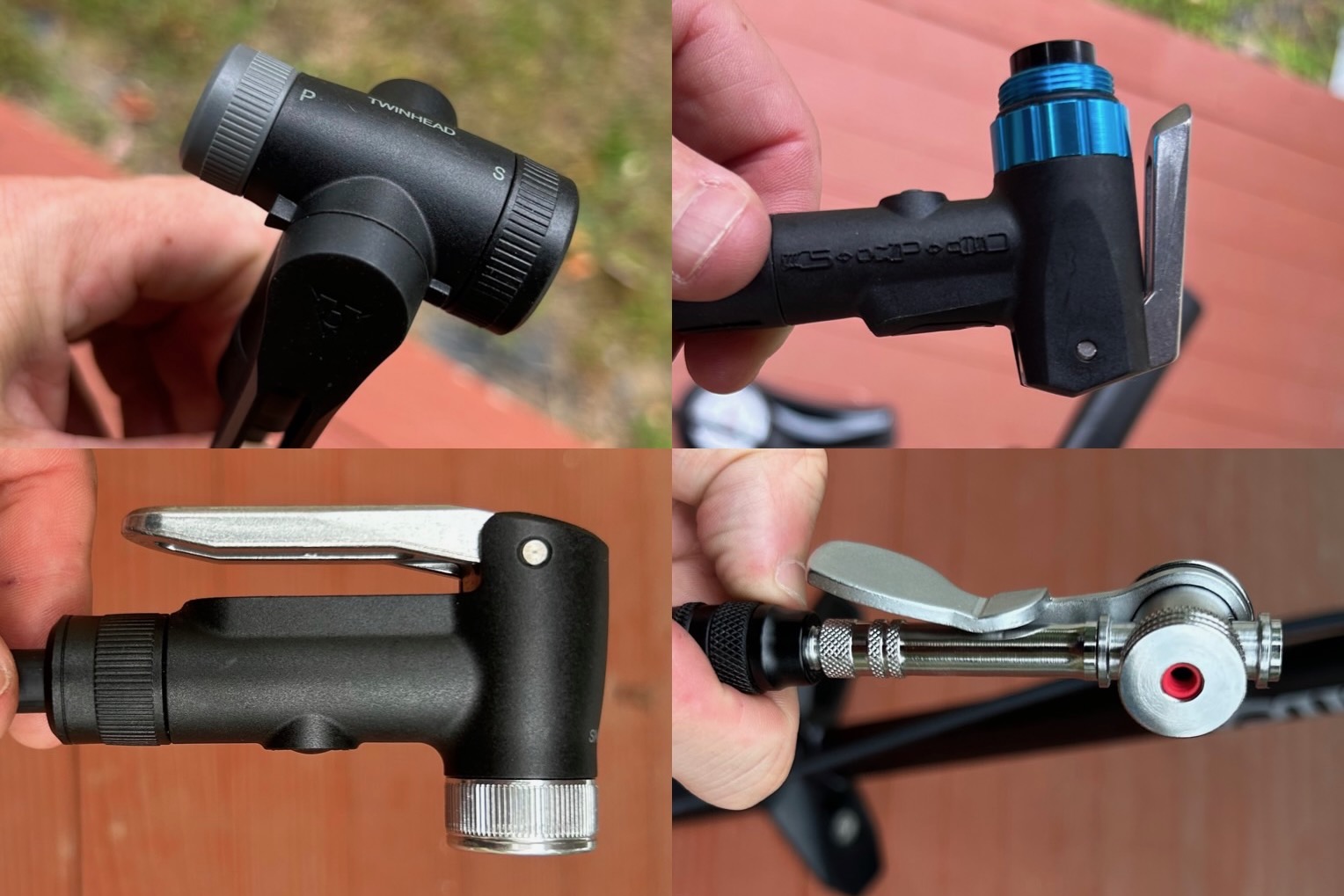

Pumping Efficiency
Pumping efficiency is a function of how much air is pushed through the pump into the tire during each stroke, and its importance will vary somewhat depending on whether you need high volume or high pressure or both. All of the pumps we tested will fill your tires relatively quickly, and regular top-offs will typically only require a few pumps.
We tested pumping efficiency by counting how many strokes it took to fill a Maxxis Minion DHRII to 30 psi five times and then taking the average. Across all the pumps we tested, the average number of strokes to 30 psi was 36, with the Bontrager Dual Charger leading at 22 pumps (on high volume mode) and the Topeak Joe Blow Booster requiring the most at 47.
Having used many pumps over the years, none of the pumps we tested felt super slow — but a more efficient pump will always save time and effort and may be worth consideration if you are frequently filling tires.
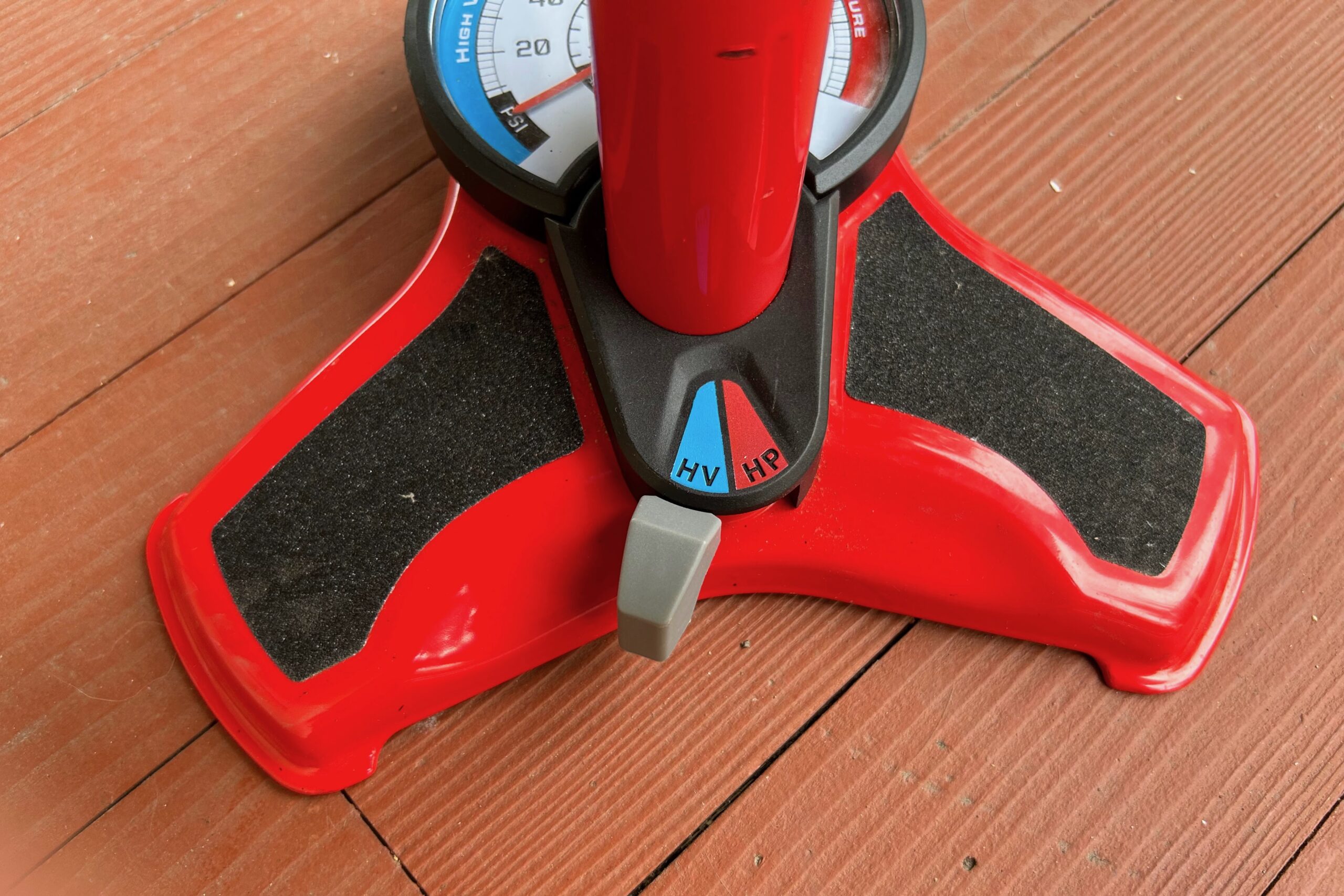

Types of Gauges
The pumps we tested come with either analog gauges/dials or battery-powered digital displays. Both types work relatively well, although their location and size can make some more easy to read than others. In general, digital displays are considered to be more precise as they can show the pressure readings in smaller increments than can be read on most analog dials.
That said, a digital gauge generally adds to the cost of a bike pump and will require you to change a battery at some point in its lifespan. Many brands make pumps with both types of gauges, so you have options to suit your preference.
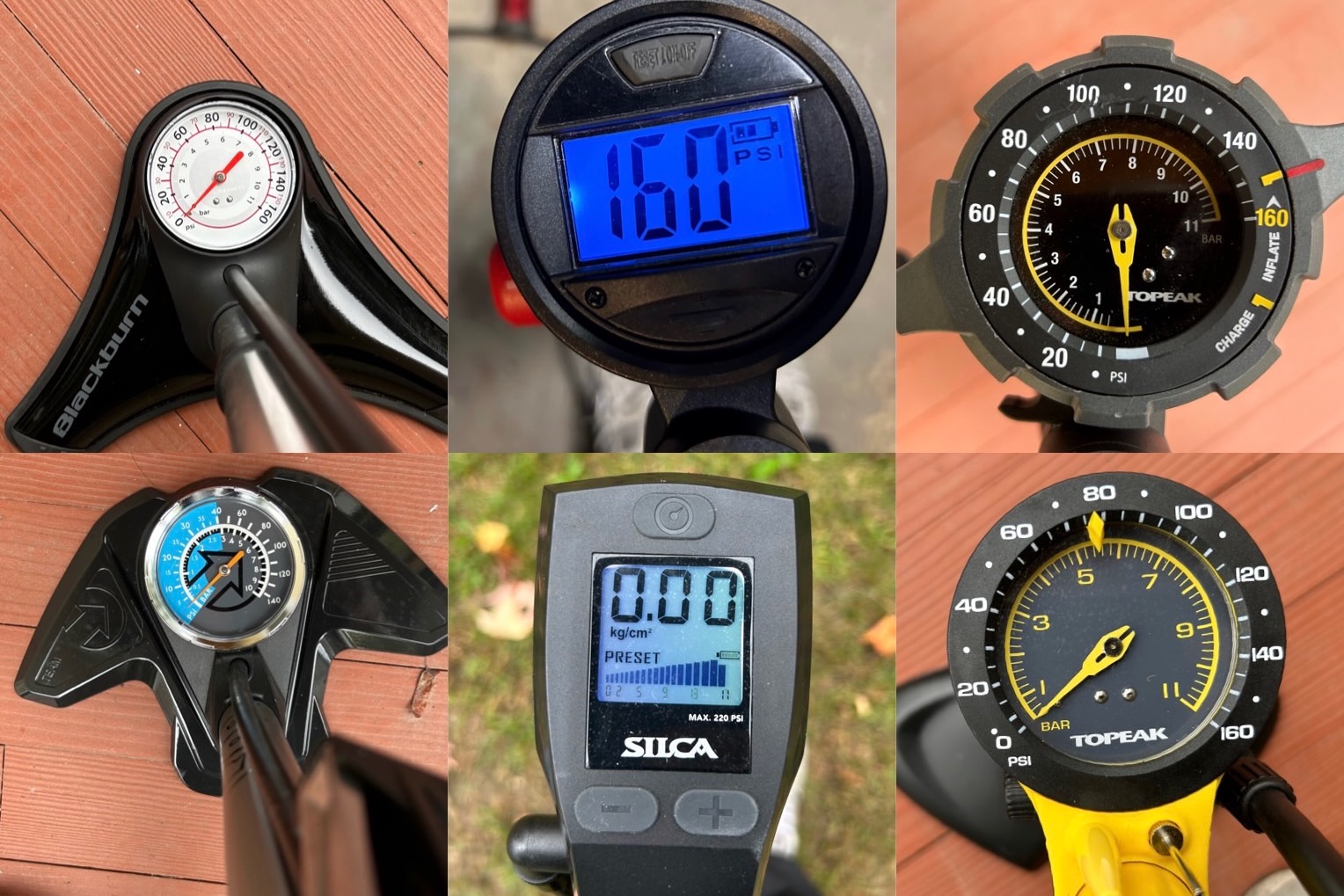

Gauge Accuracy
Most gauges are fairly accurate and will get you within a few psi of your desired pressure. We measured the accuracy of both analog and digital gauges by pumping up tires by 10 psi at a time, checking the gauge pressure at each interval against the pressure read by our Topeak SmartGauge D2X digital pressure gauge, and taking the average difference percentage from pump gauge pressures at 10, 20, 30, 40, and 50 psi.
On average, pump gauges showed pressures 2.45% higher than the D2X digital gauge, with the most accurate pump (the Bontrager TLR Flash Charger) averaging readings 1% lower than the digital gauge and the least accurate pump (the Bontrager Dual Charger) averaging 6.6% higher readings than the Topeak gauge.
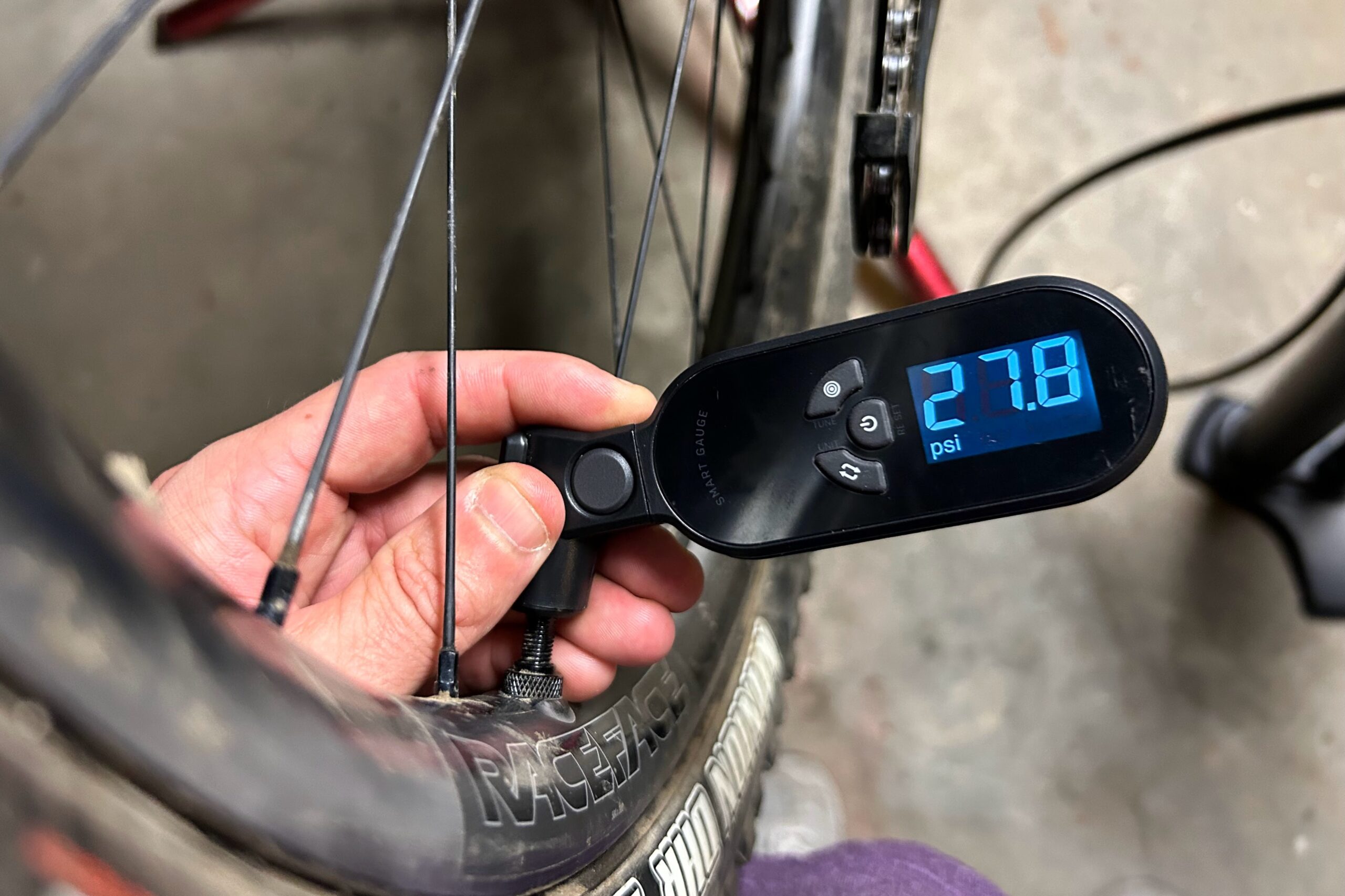

But how important is gauge accuracy? If you usually use the same pump to inflate your tires, it may be slightly annoying that it isn’t perfect, but it should be easy to work with. Finding the optimal pressure for your tires, rims, terrain, and riding style requires experimentation, and if you are using the same pump every time, you can feel pressure changes by using any baseline reading from the pump.
You may find that your tires feel great at 28 psi on your pump dial, which might read 24 psi on a digital pressure gauge. But you know that using your pump, you like the feel of 28 psi on that gauge, so you can compensate for the difference.
Since changes in tire pressure can have a relatively large effect on the feel and performance of your tires on road, mountain, and gravel bikes, having a separate pressure gauge is always a good idea for those looking to get the most from their tires. This will help ensure consistency and accuracy, and most feature an air release button for fine-tuning pressure. We used the ToPeak SmartGauge D2X, which, while somewhat expensive, we found to work very well.
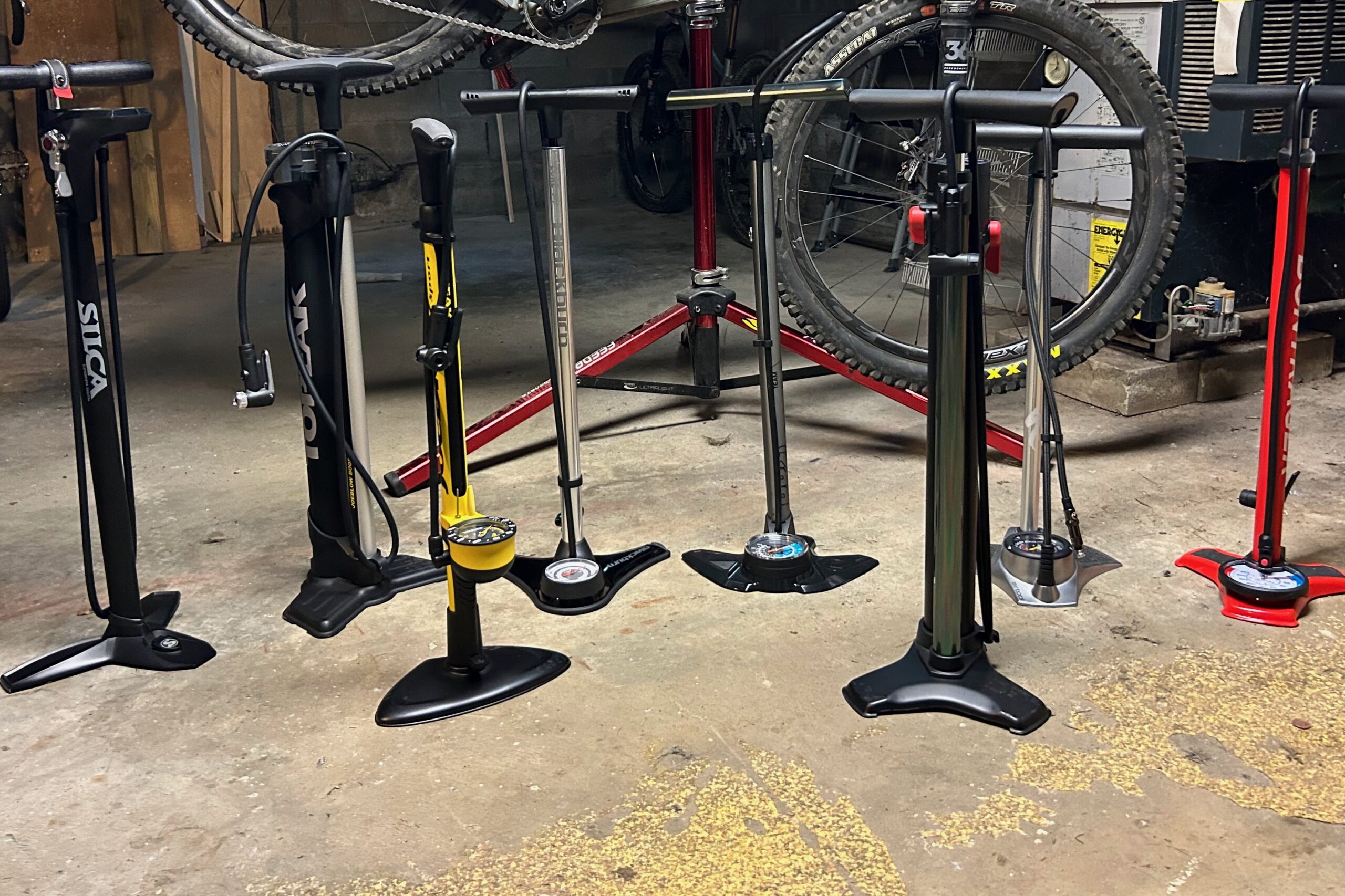

Stability
While it isn’t the most important aspect of a bike pump’s performance, stability in use is definitely a consideration, and they are not all created equal in this regard. In general, the more stable, the better, so you’re not constantly knocking it over in your workspace or having to constantly stabilize it with your feet while pumping.
We found that we preferred pumps with wide, three-legged feet for multi-directional stability, and we also appreciated pumps like the Silca Superpista Digital and Blackburn Core 3 for their rubber padding on the bottom of the foot, which helped avoid slippage and floor scratches.
Durability
Quality bike pumps can be shockingly durable and last for decades if treated with a reasonable amount of care. Most mid to high-end models are made with steel or alloy bodies and feet, and many can be repaired if they are damaged. Plastic tends to be cheaper but much less durable, so typically, spending a little more on a pump will get you a longer-lasting product.
We recommend buying from recognizable name brands like Silca, Bontrager, Specialized, ToPeak, Blackburn, and Lezyne, as they are most likely to stand behind their products with warranties, and many have replacement parts to keep your pump running smoothly should it ever get damaged.
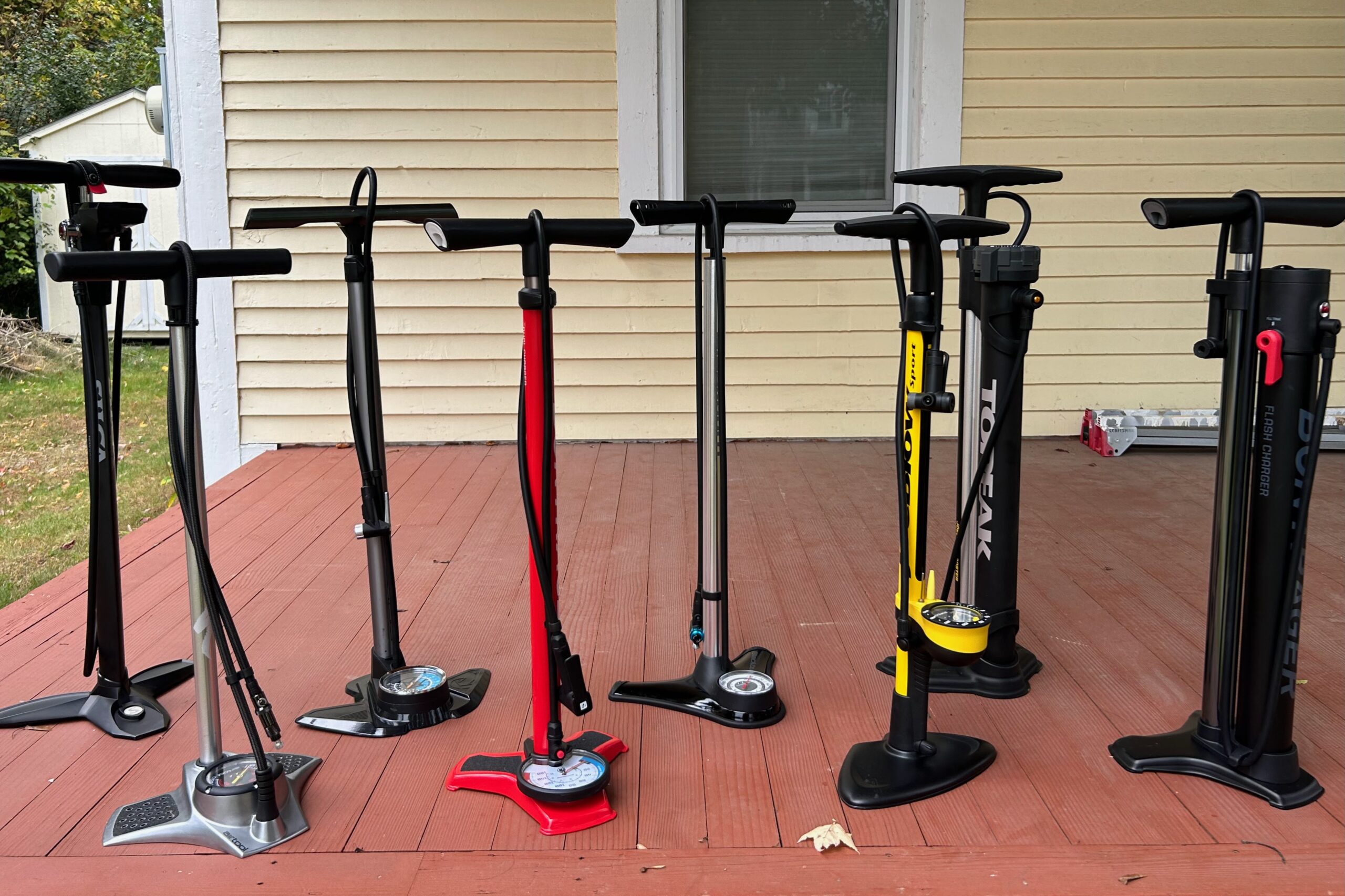

Price & Value
In the grand scheme of things, bike pumps are relatively affordable tools that usually last for many years. You don’t need to break the bank to get a great pump that covers your needs — pumps are fairly simple things, after all. That said, spending more typically gets you smoother pumping action, more accurate gauges, higher-quality materials, and more durability.
Budget
If you’re truly operating on a budget, the super affordable AerGun X-1000 ($40) will get the job done. Despite the bargain price, this pump works well enough even if it is less attractive, less stable, and has lots of plastic parts. Spend a little more for a pump like the ToPeak Joe Blow Sport III ($60), and the build quality is noticeably higher. Even at an affordable price, this pump is great, and we have been using one of these for many years with no issues.
Most mini-pumps fall into the budget price tier. These pumps are small, relatively simple, and use less material, so they cost a bit less, even if they are incredibly useful tools. One of our most recent favorites is the Lezyne Tech Drive HV ($45), which fills high-volume tires quickly for a mini pump. Bear in mind, however, that mini pumps are best used out on the road or trail and are typically bought in addition to a floor pump in the workshop.
Mid-Tier
One of our favorite pumps of the test was the Bontrager Dual Charger ($80). While it could qualify as a budget option for the price, it is just a bit more expensive. This pump has a large, accurate gauge and works with both high-volume and high-pressure tires with the flip of a switch. We’re happy to pay a little more for that versatility.
Pumps with special features, like tubeless booster pumps, require more materials and engineering, and they typically command a higher price as a result. Still, the Bontrager TLR Flash Charger ($175) is well-priced compared to other tubeless pumps and could be worth its weight in gold if you frequently install tubeless tires at home.
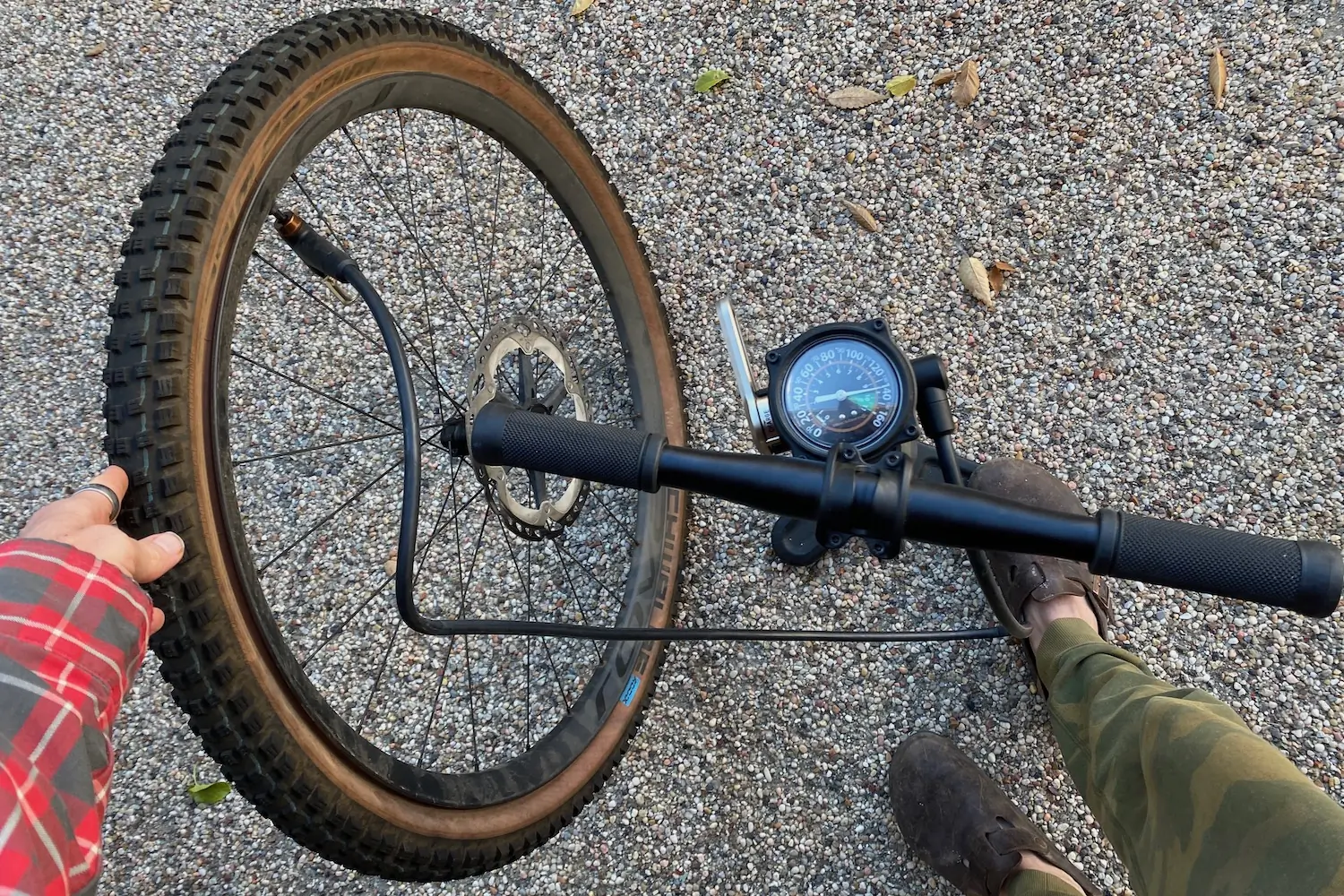



Premium
At the highest end of the price spectrum, at and above $200, we find more pumps with special features like tubeless boosters as well as the most durable and highest-quality pumps on the market. Both the Blackburn Chamber Tubeless ($200) and the Topeak Joe Blow Booster ($220) are great dual-purpose pumps for seating tubeless tires and as a regular floor pump.
The Silca Pista Plus ($200) commands a high price for its impressive accuracy, super smooth pumping action, and world-renowned durability — these pumps are known to last for decades and could become a family heirloom. At the highest end of the market, the Silca SuperPista Digital ($349) builds off the Pista Plus platform with the addition of a digital pressure gauge and premium valve chuck. At that price, it won’t be for everyone, but it is an impressively well-made bike pump that’s sure to please anyone willing and able to spend that much.
Frequently Asked Questions About Bike Pumps
Well, some track racers do pump their tires to 160 psi or more, but that’s only because they are riding on a perfectly smooth surface in a controlled environment. Regular riding outdoors, on real roads and trails, needs far less tire pressure.
Recently, and especially with tubeless tires becoming the norm, it’s been proven that lower tire pressures yield more comfort, better traction, and improved efficiency. Yep, lower really is better. Brands like Silca have even made guides to help you find your best tire pressure.
So, why do floor pump gauges read so high? Because they need to account for the pressure spikes that occur when pumping. Next time you’re inflating your tire, notice how the needle spikes really high on each stroke. The gauge needs to have room for those spikes or it can be damaged, which means it will no longer be accurate. Specifically, they need 20-30% extra in order to safely cover the higher pressures generated during your pump stroke.
What about portable pumps and CO2 cartridges?
We’ve tested several mini-pumps and have listed our favorites above. Portable hand pumps and CO2 cartridges are intended for use on the trail and should be carried on longer rides, especially on longer rides that you won’t want to walk out of if something goes wrong. But, due to the small size of portable hand pumps, they are time consuming to use with high volume tires and difficult to use with high pressure tires. The Lezyne Tech Drive HV is one of our favorites.
CO2 cartridges are compact and easy to carry in a hip pack (or in frame storage), but they are low volume and can only be used once. Hand pumps and CO2 cartridges are great for use on the road or trail, but we recommend investing in floor pump to make maintenance easier at the house.
An interesting mini-pump option for those who like to use CO2 but also want to have a pump as a backup is the Blackburn Mammoth CO2. The head of this pump comes off and works as a CO2 inflator. That way you can carry one less thing with you while you ride and still be prepared.
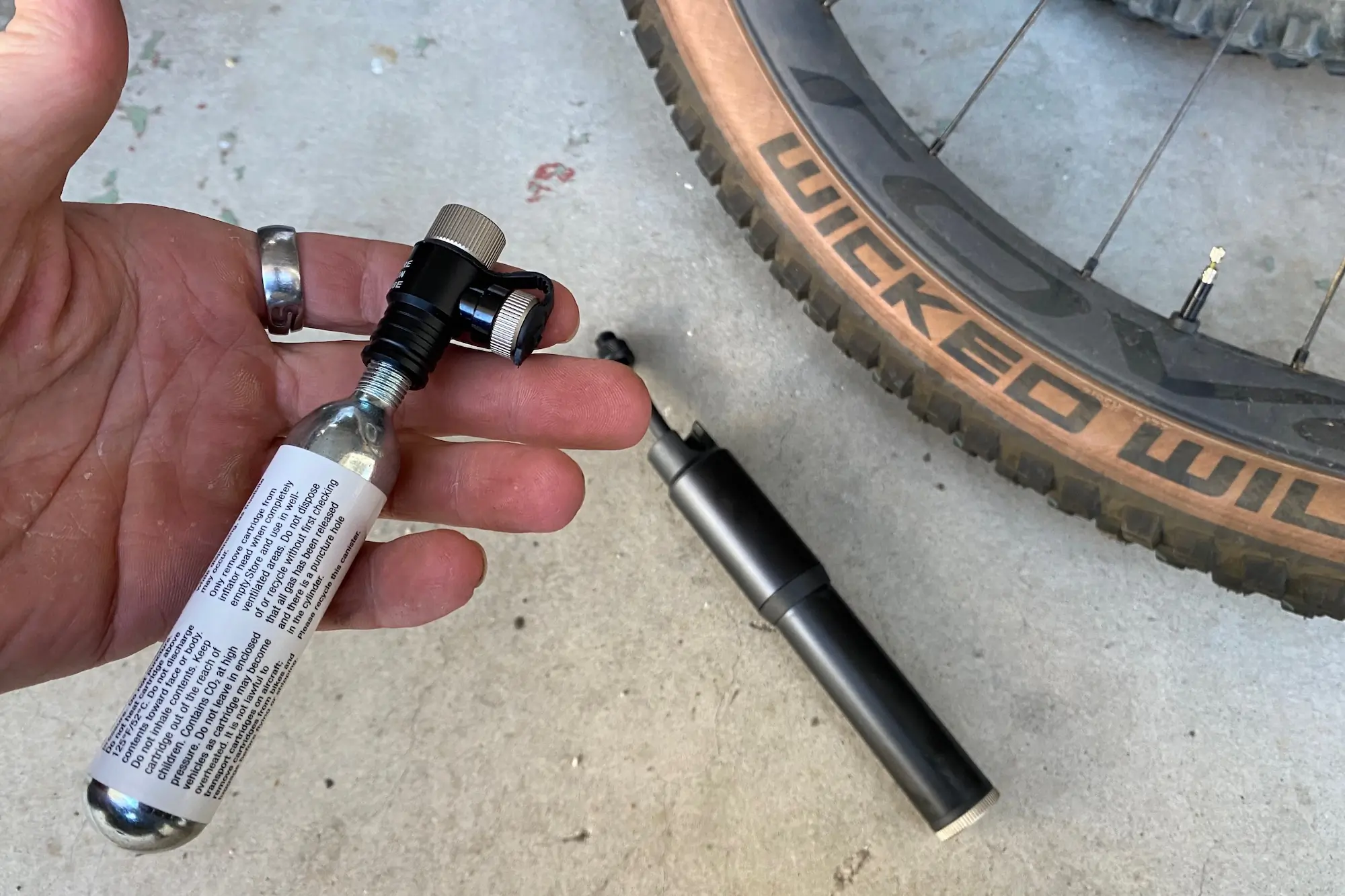



What about air compressors?
Air compressors are great for tubeless setup. But, they are also relatively expensive, loud, and difficult to throw in your car for a road trip. While having an air compressor is wonderful, floor pumps are an indispensable piece of gear that makes it easy for any cyclist to keep their tires inflated to their desired pressure. Portable inflators are becoming more common, however, and can be a useful tool to have on hand as well.
It depends on the type of bike and tire you’re running. All bike tires will have a recommended psi range listed on their sidewalls, so try to stay within that range. For most road riders, pumping tires to between 70 and 90 psi is a good starting point, while mountain bikers will run anywhere from 18 to 35 psi depending on the rider’s weight and the terrain. It is often a process of trial and error to find the optimal pressure for your tires, riding style, terrain, or road conditions to get the best performance from them.
Tire pressure should be checked before each ride even though it may not need to be adjusted every time you take out your bike. Some tires will hold air pressure perfectly for extended periods, but over time, and sometimes overnight, small amounts of pressure can leak that can impact your tire’s performance or even be a safety issue. Checking your pressure is quick and easy, and adding air takes only a few seconds, so it is worth doing every time you head out for a ride.
What is the difference between a shock pump and a pump for tires?
Shock pumps are optimized for use with high-pressure, low-volume air suspension components. While most air forks and rear shocks use a standard Schrader valve and shock pumps can be used to fill Schrader tubes (and ultra rare Schrader tubeless valves), they generally have a very low volume stroke and are inefficient for use with tires.
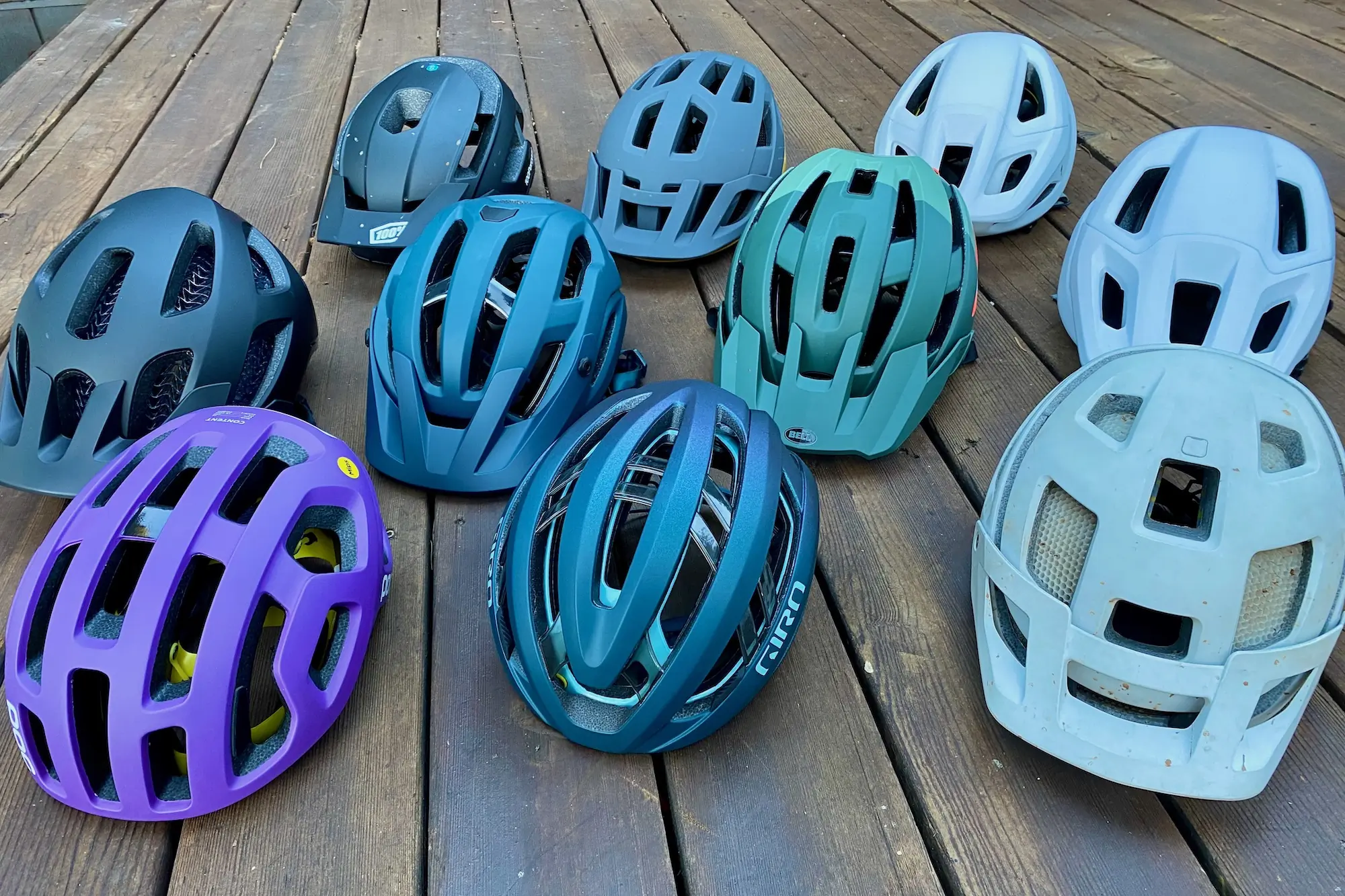

The Best Bike Helmets of 2025-2026
We bring you the best bike helmets for all types of riding, with top picks from Giro, Specialized, Thousand, and more.
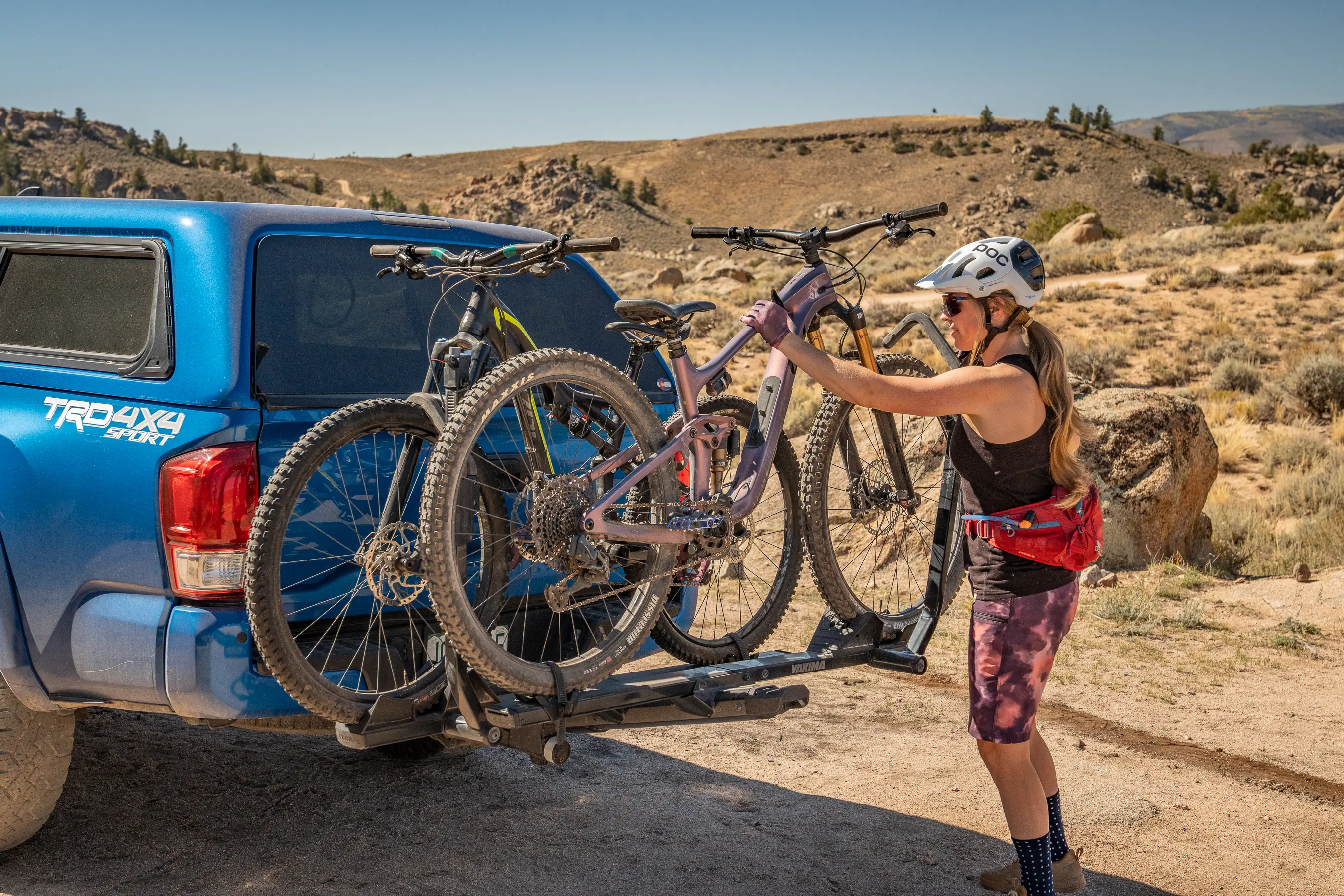

The Best Hitch Bike Racks of 2025-2026
We tested the best hitch bike racks with options for every budget. Top picks include Thule, Kuat, Rocky Mounts, and more.

